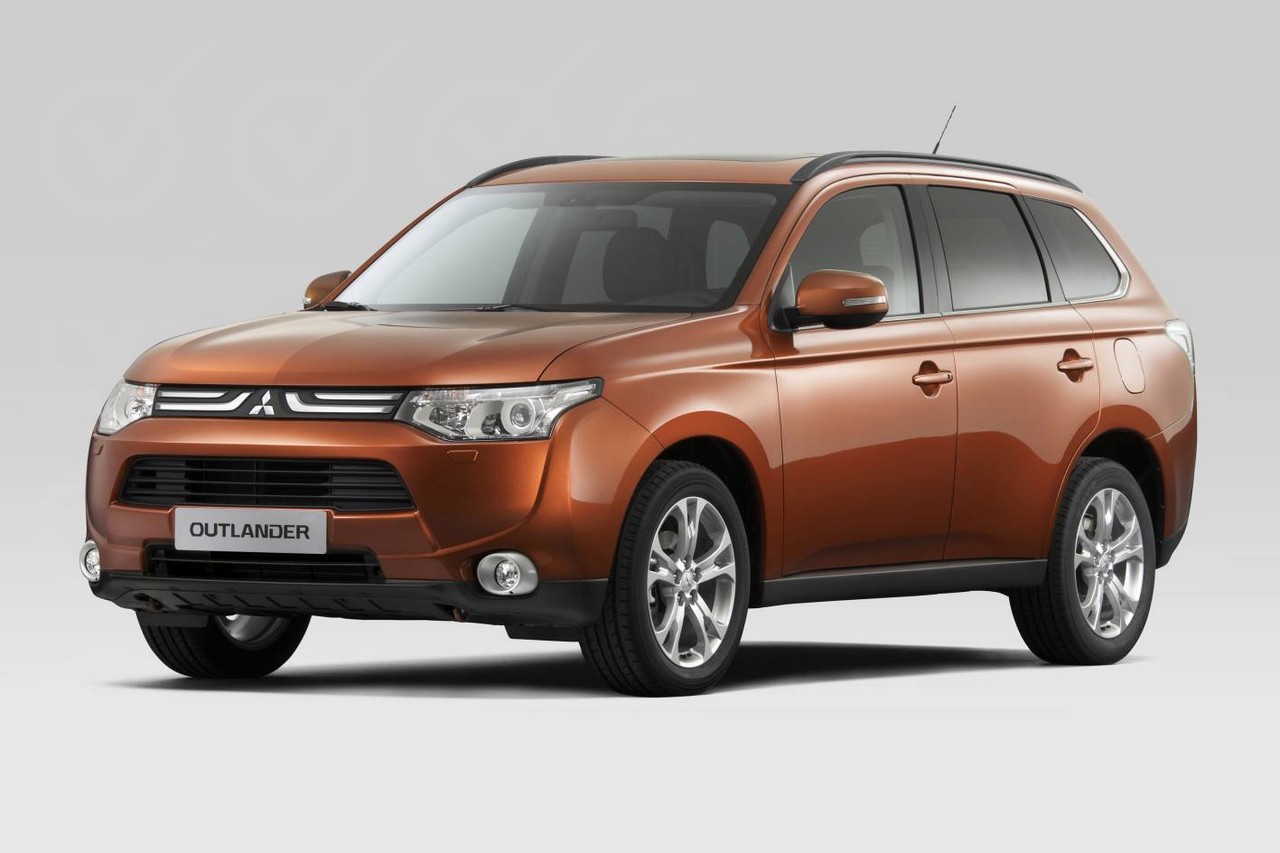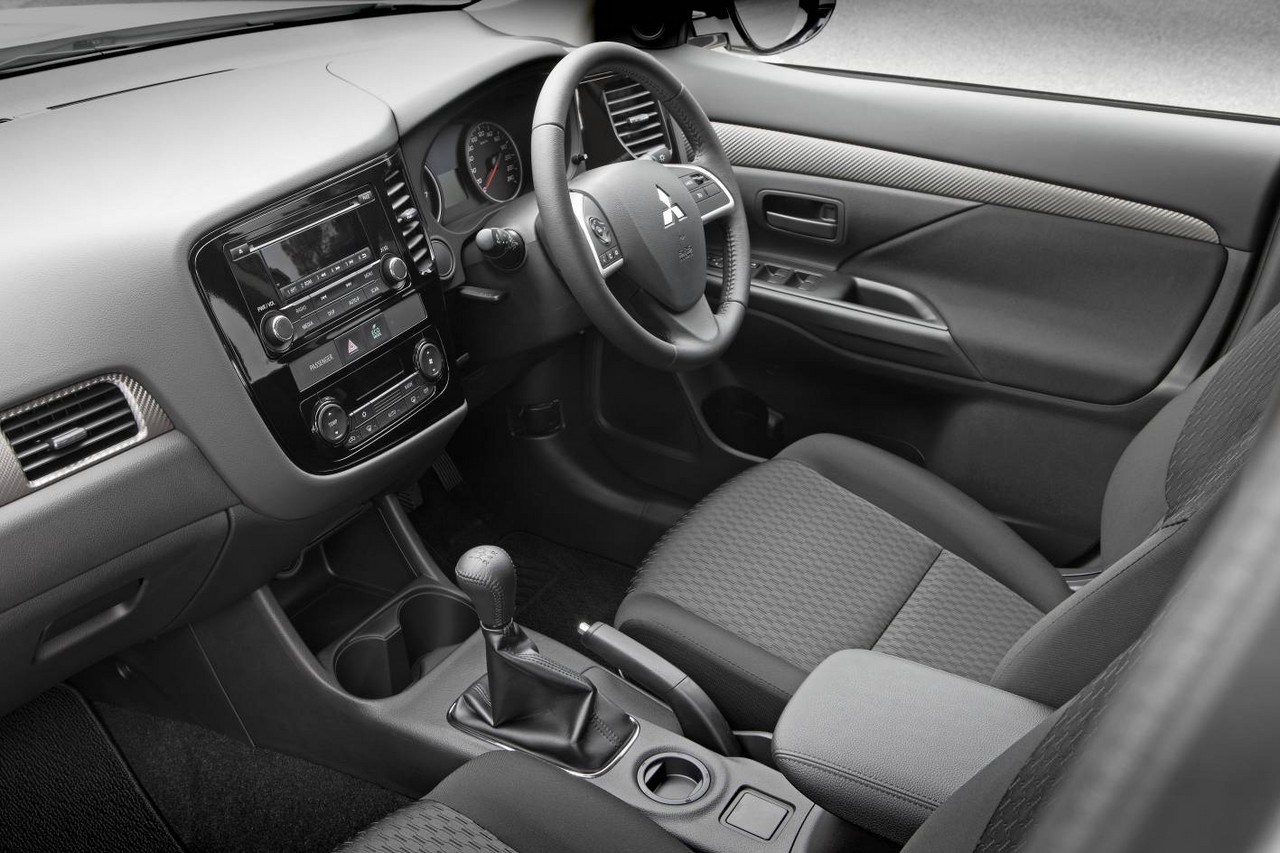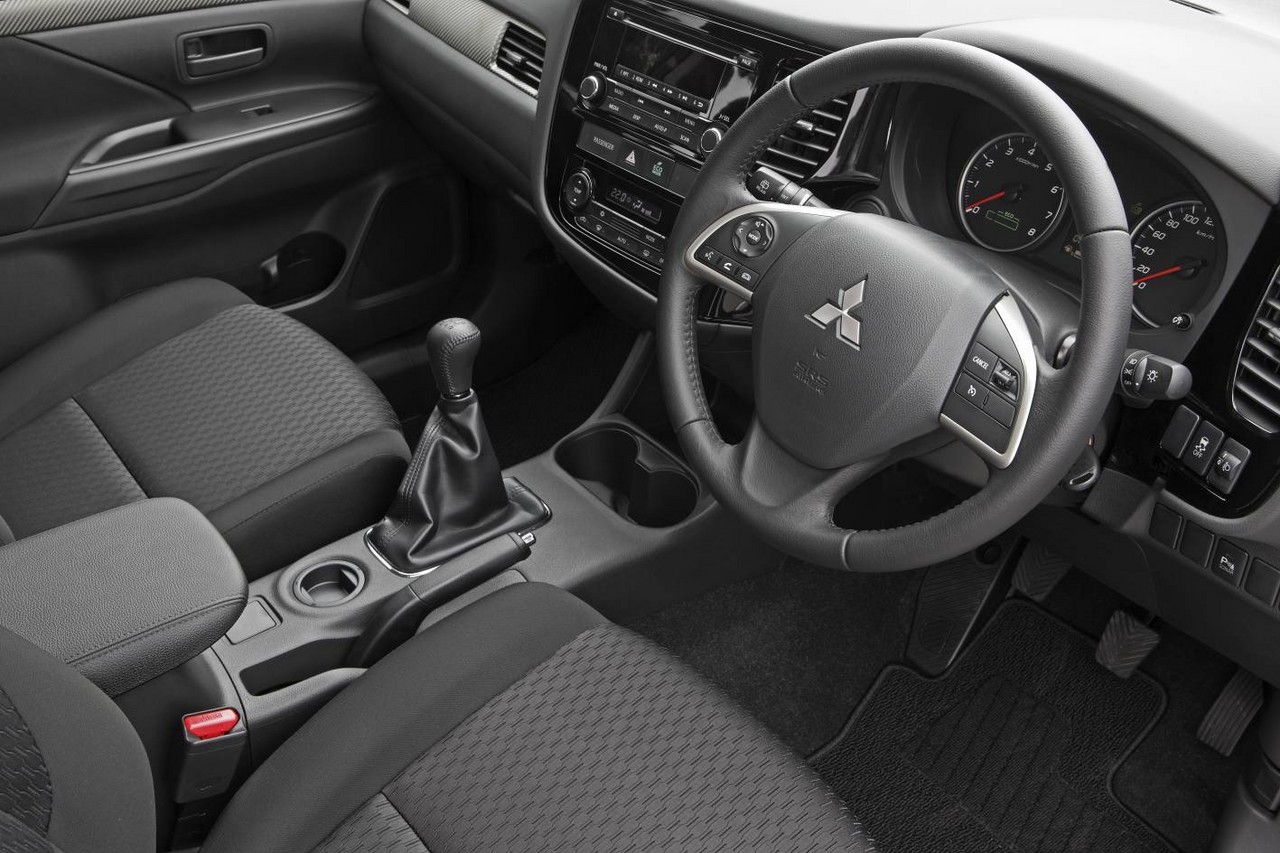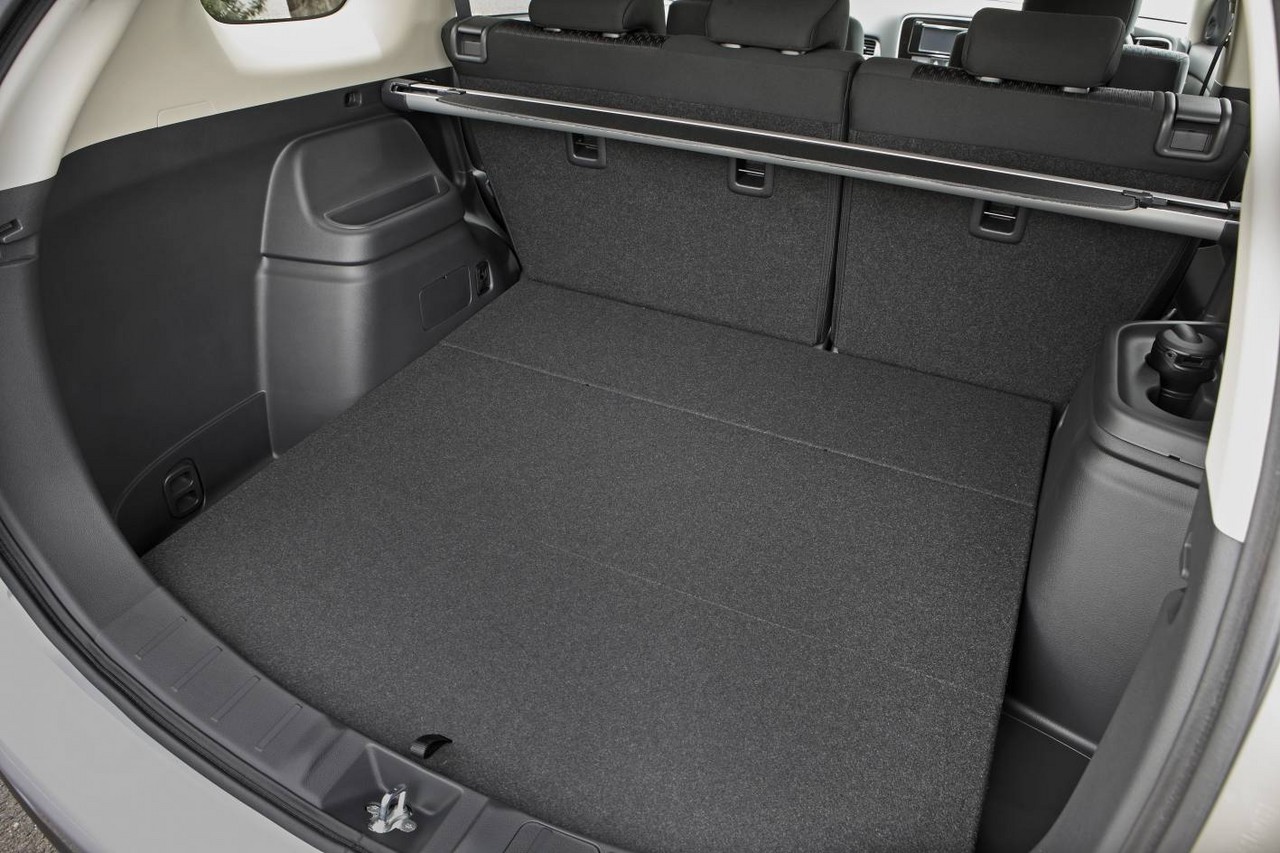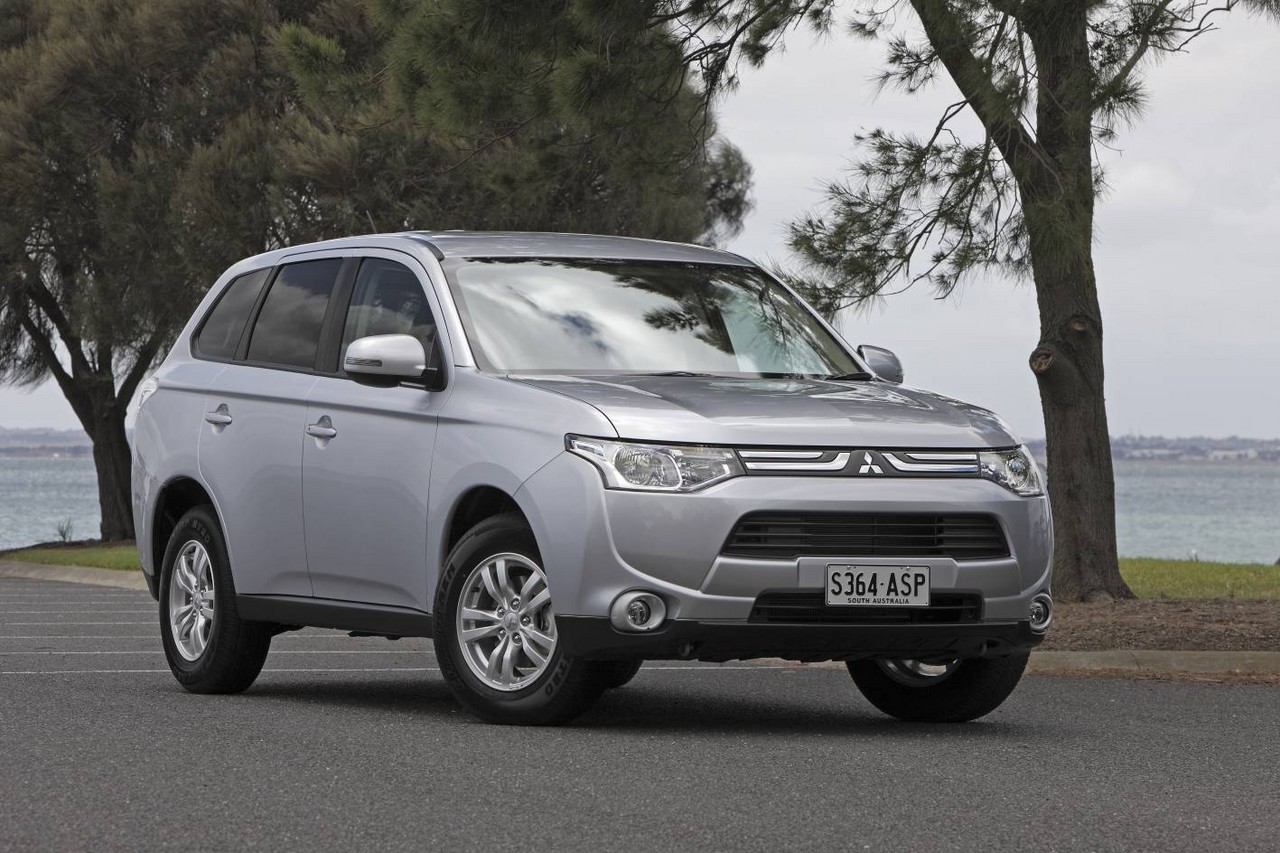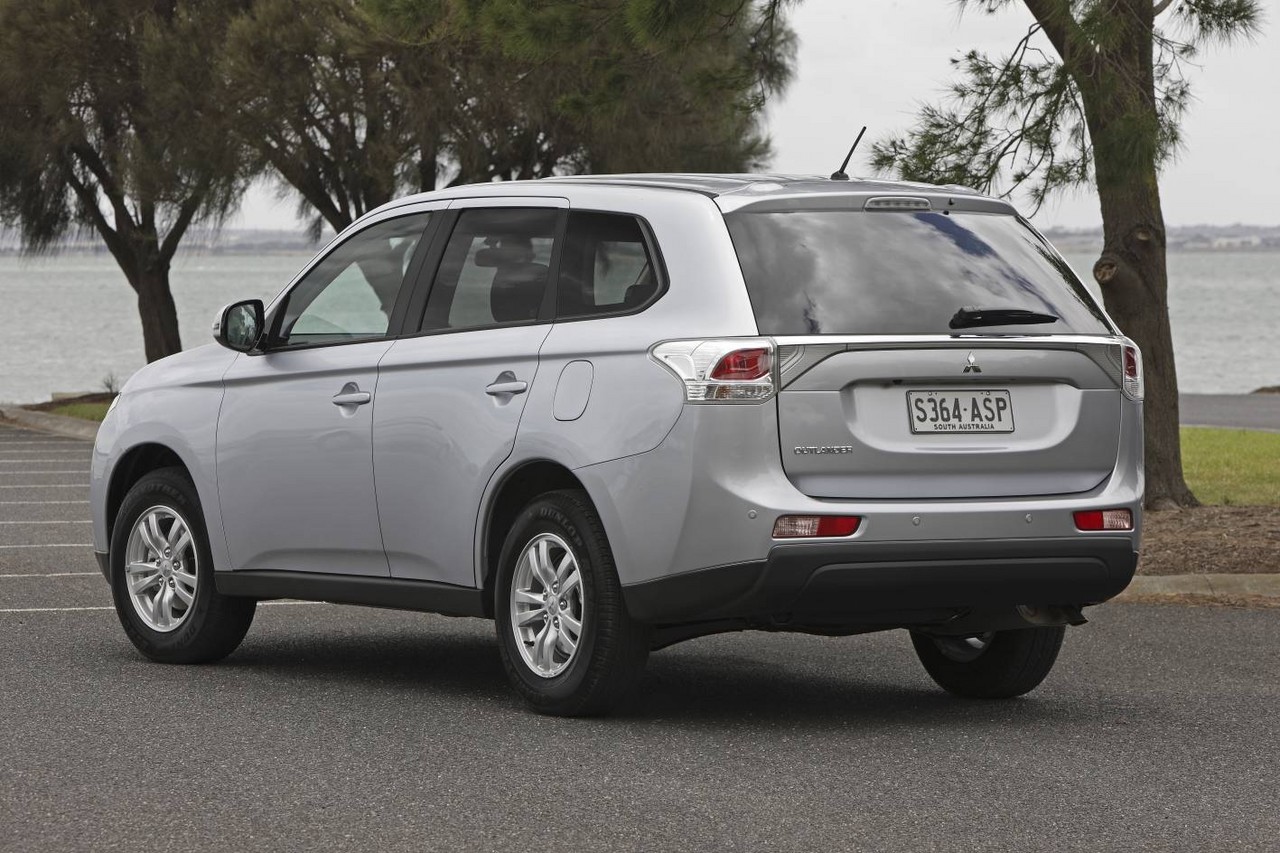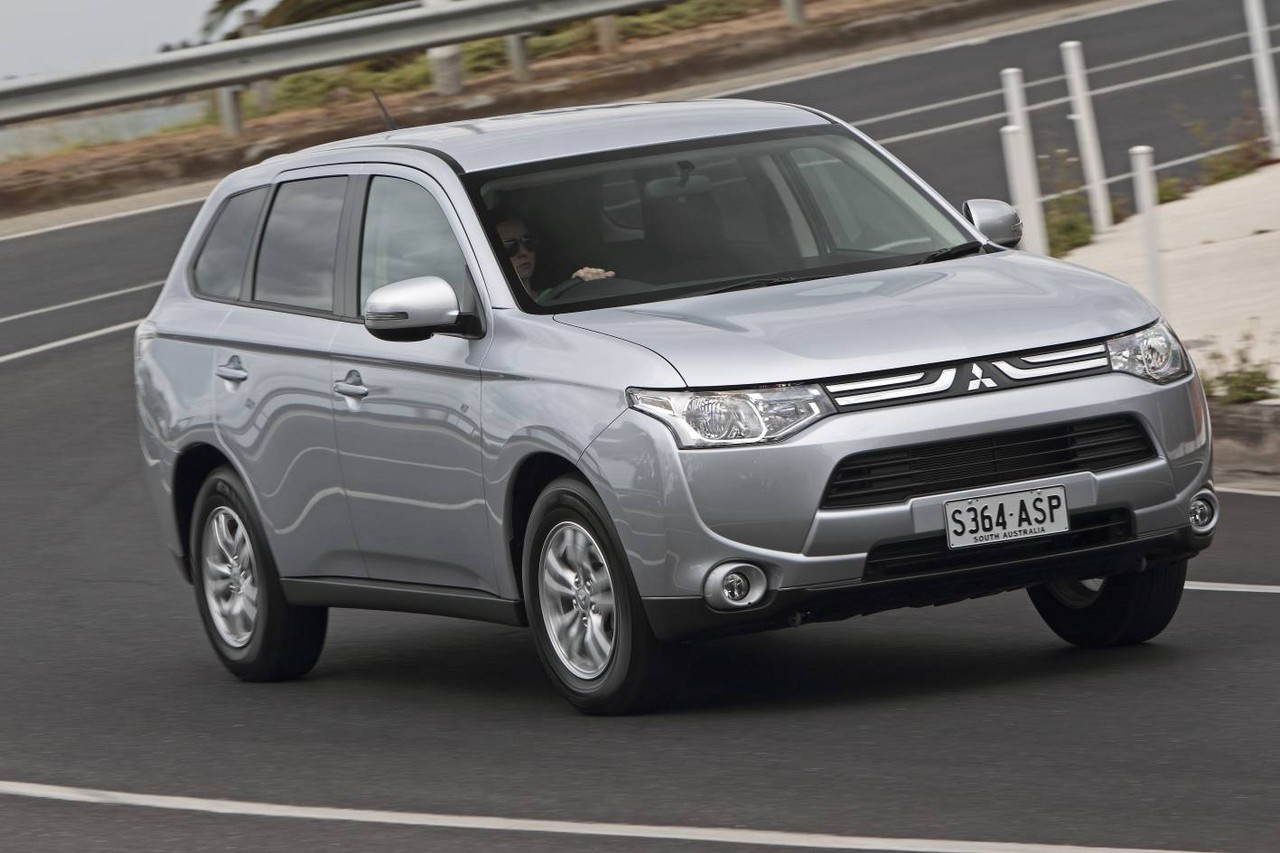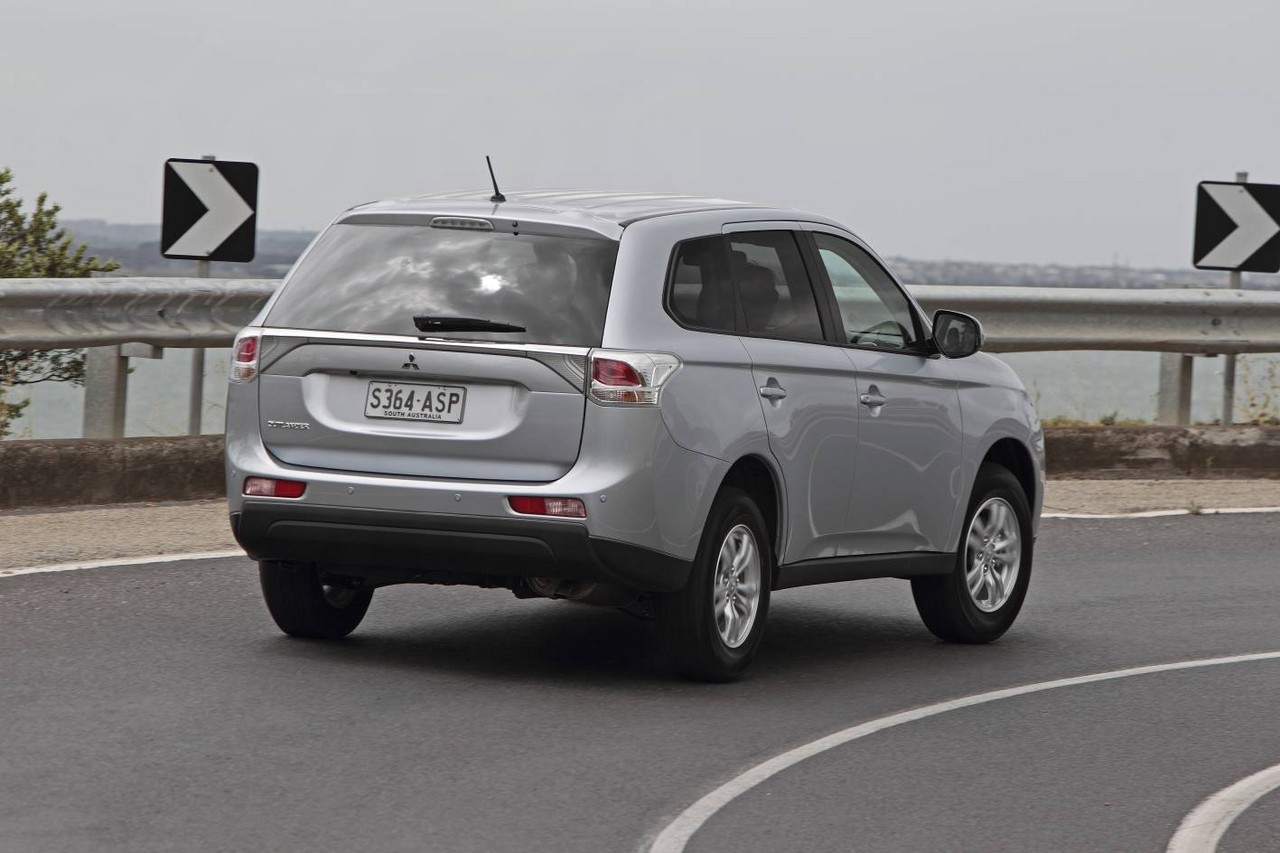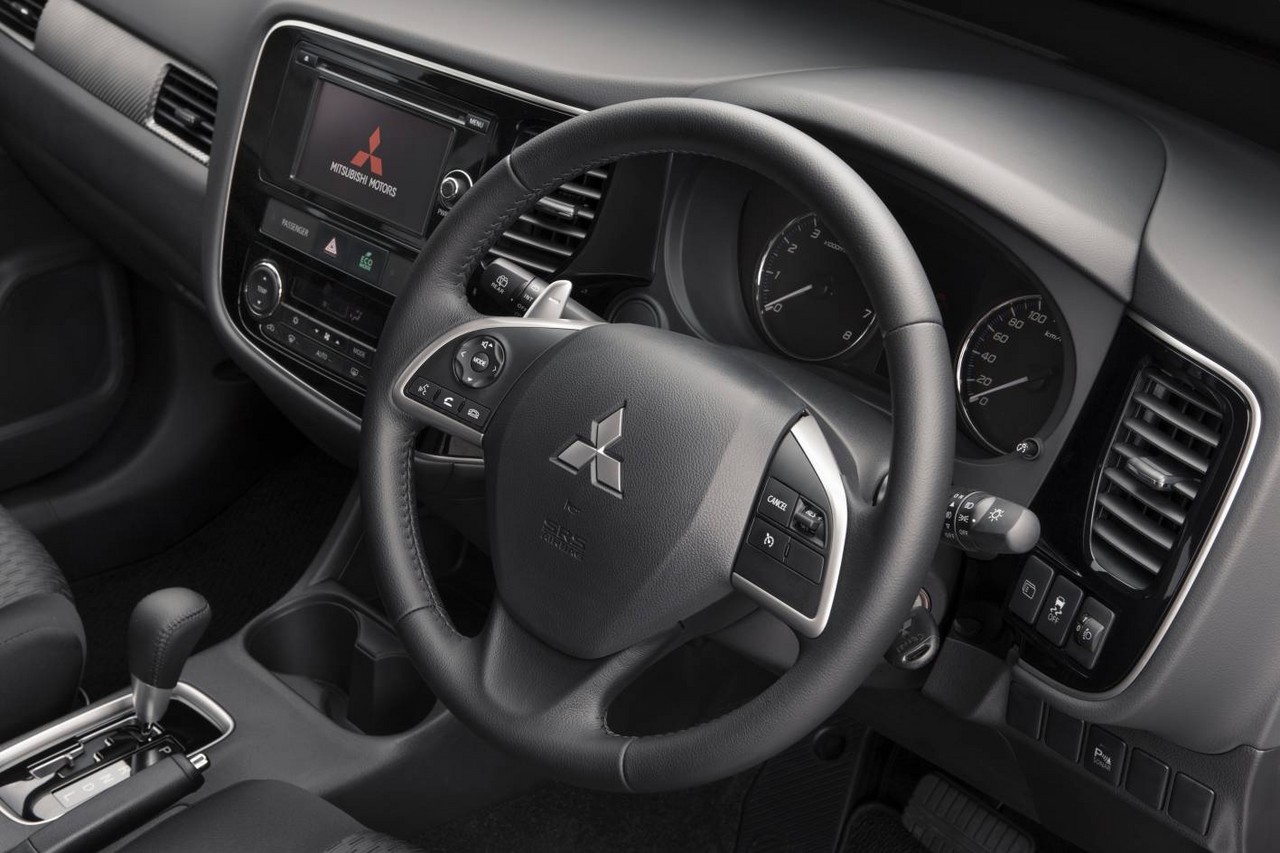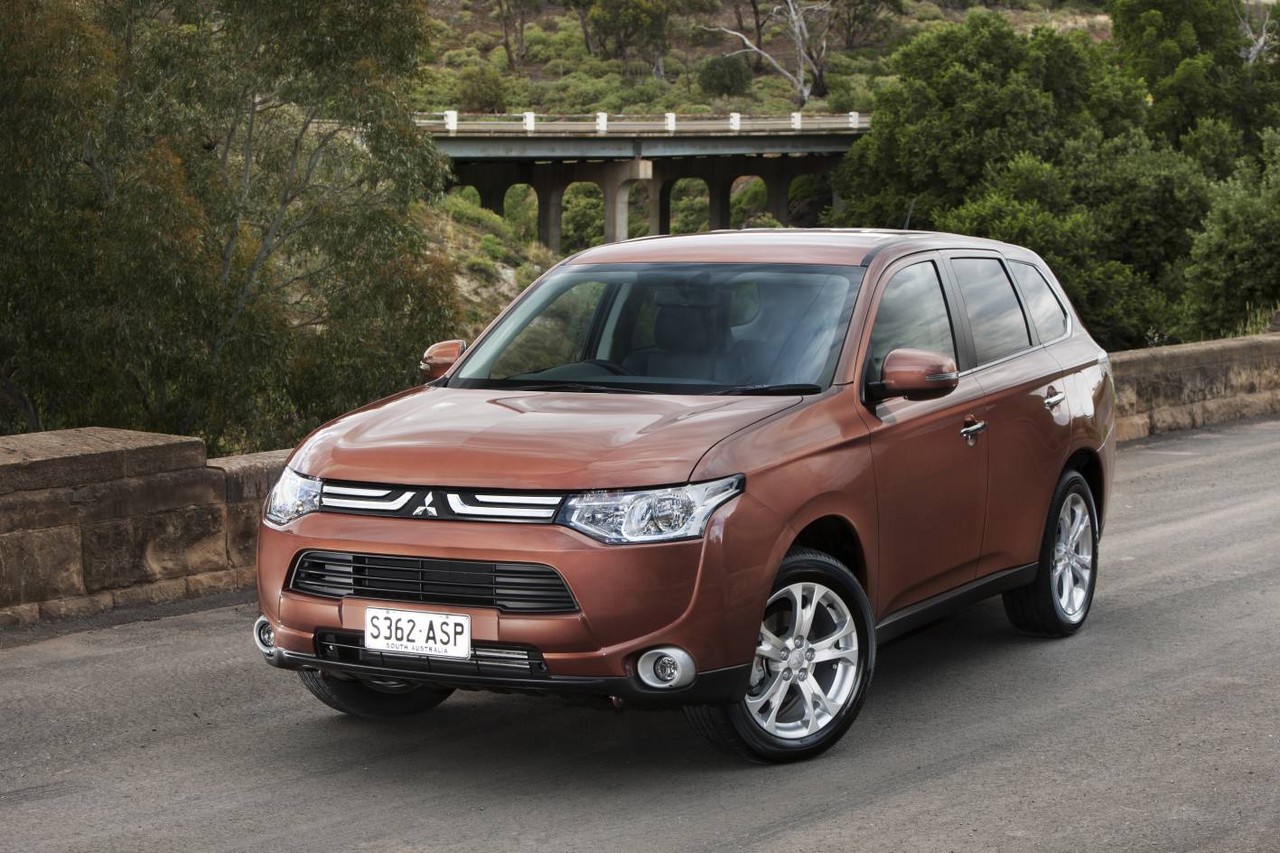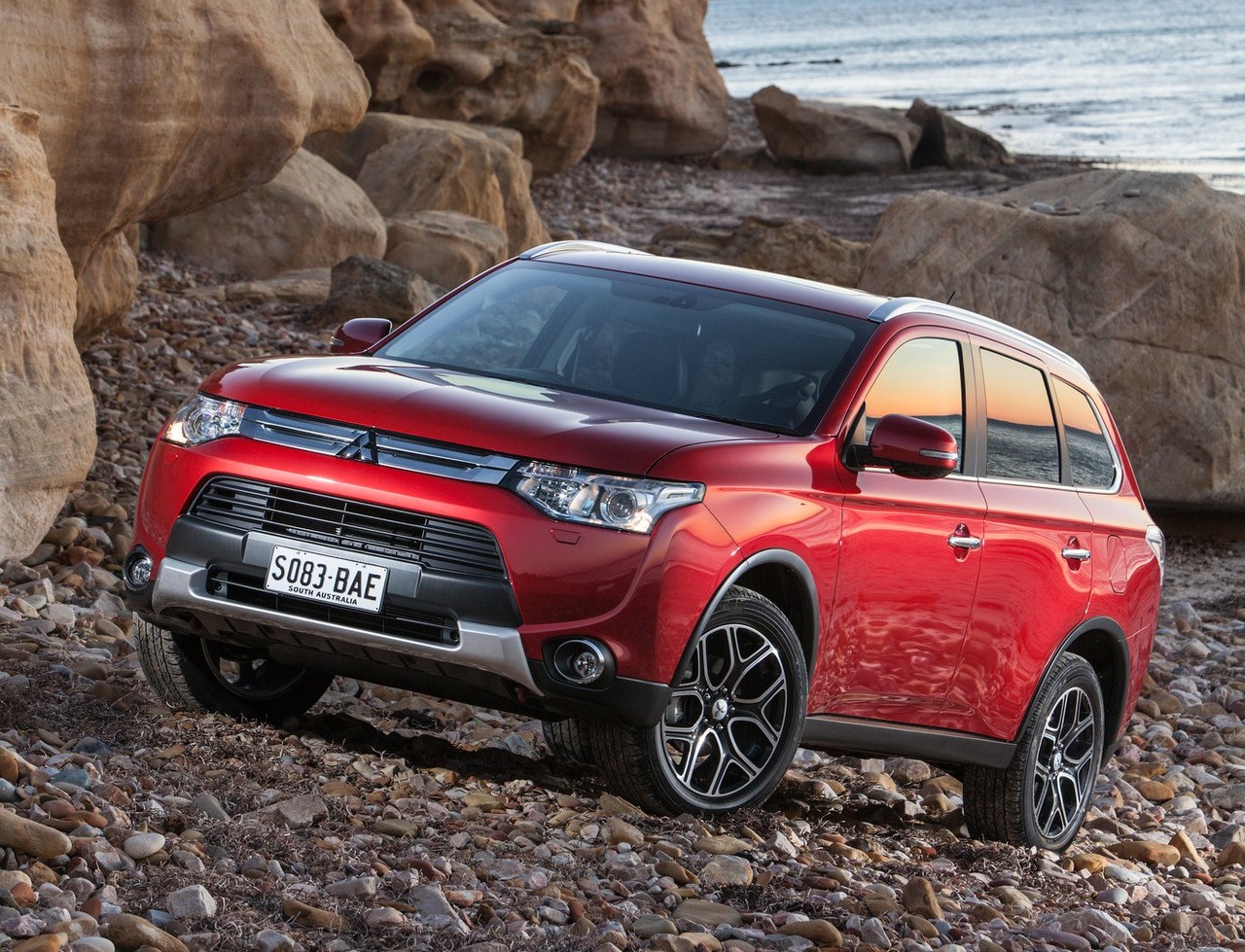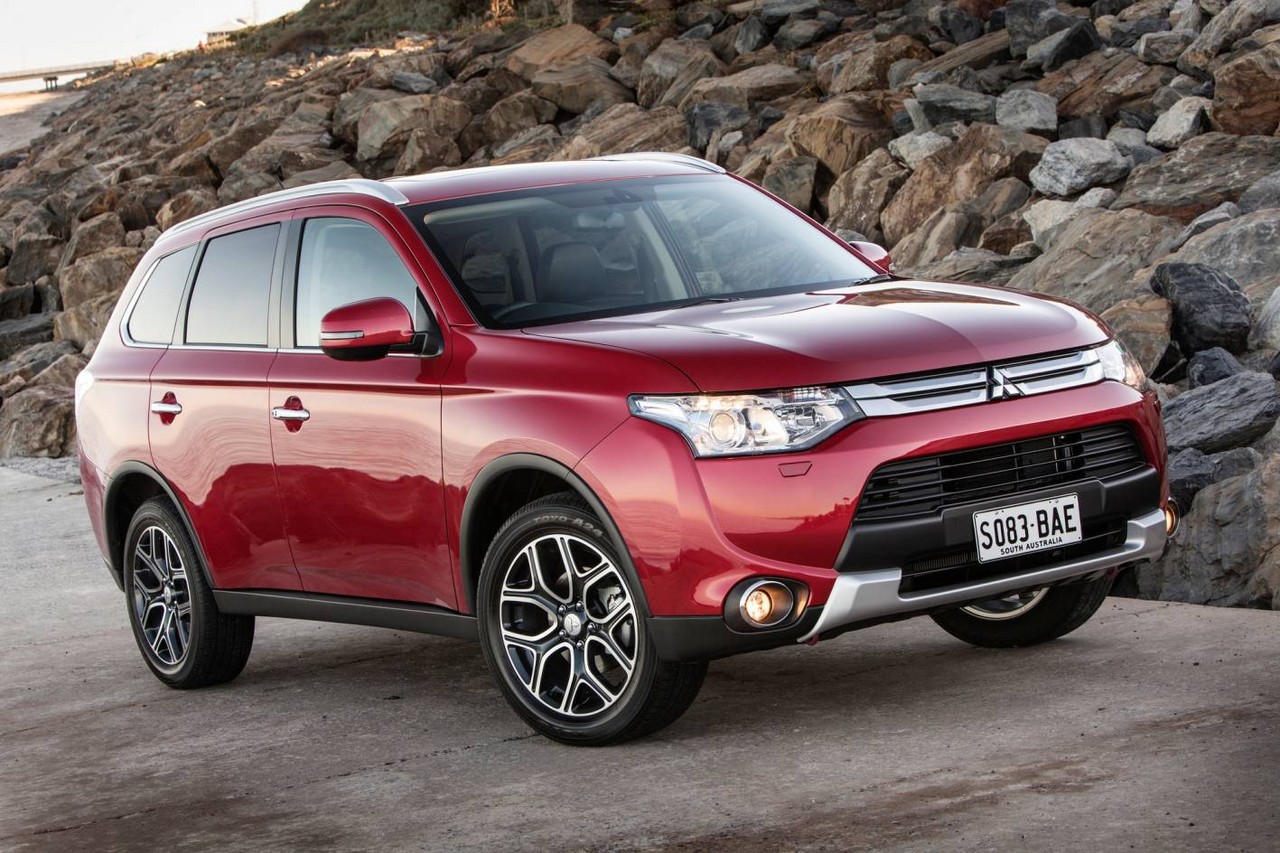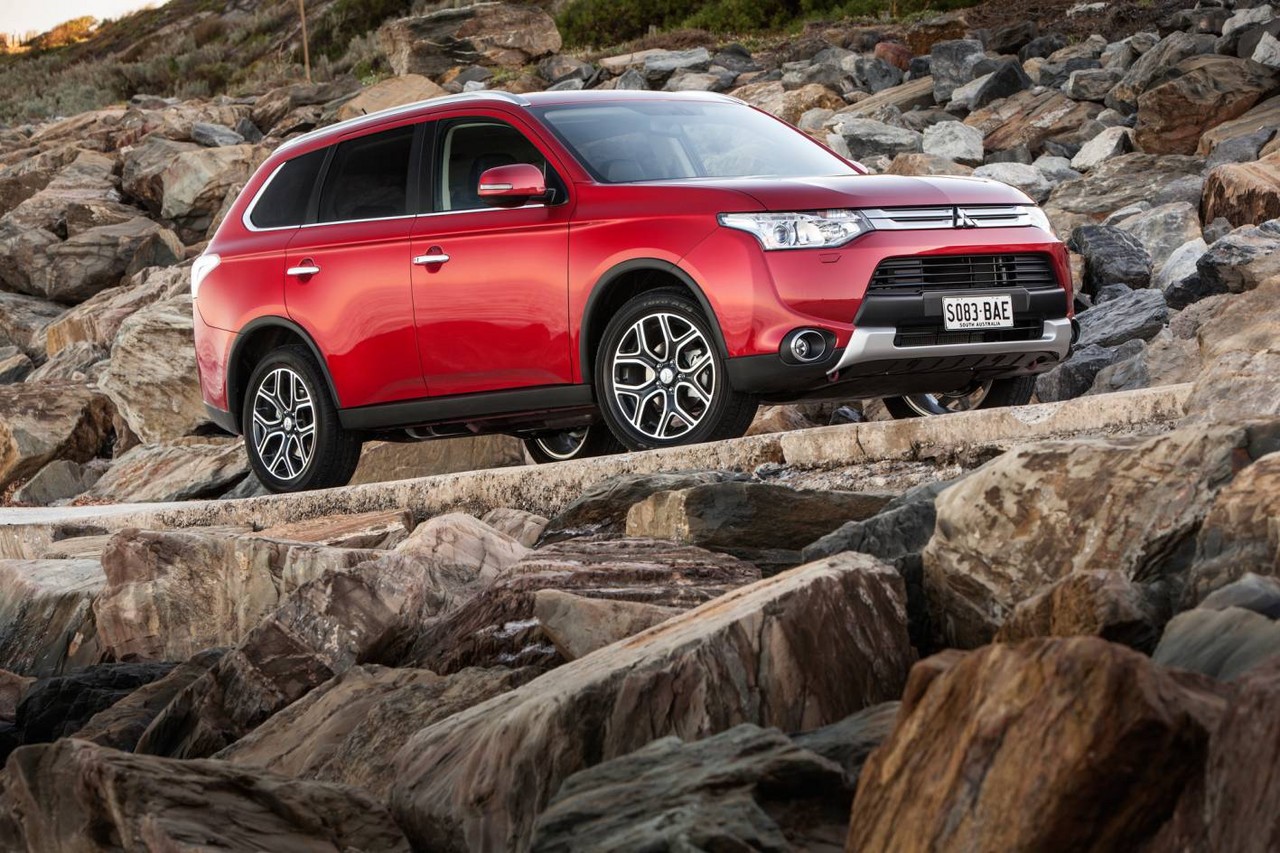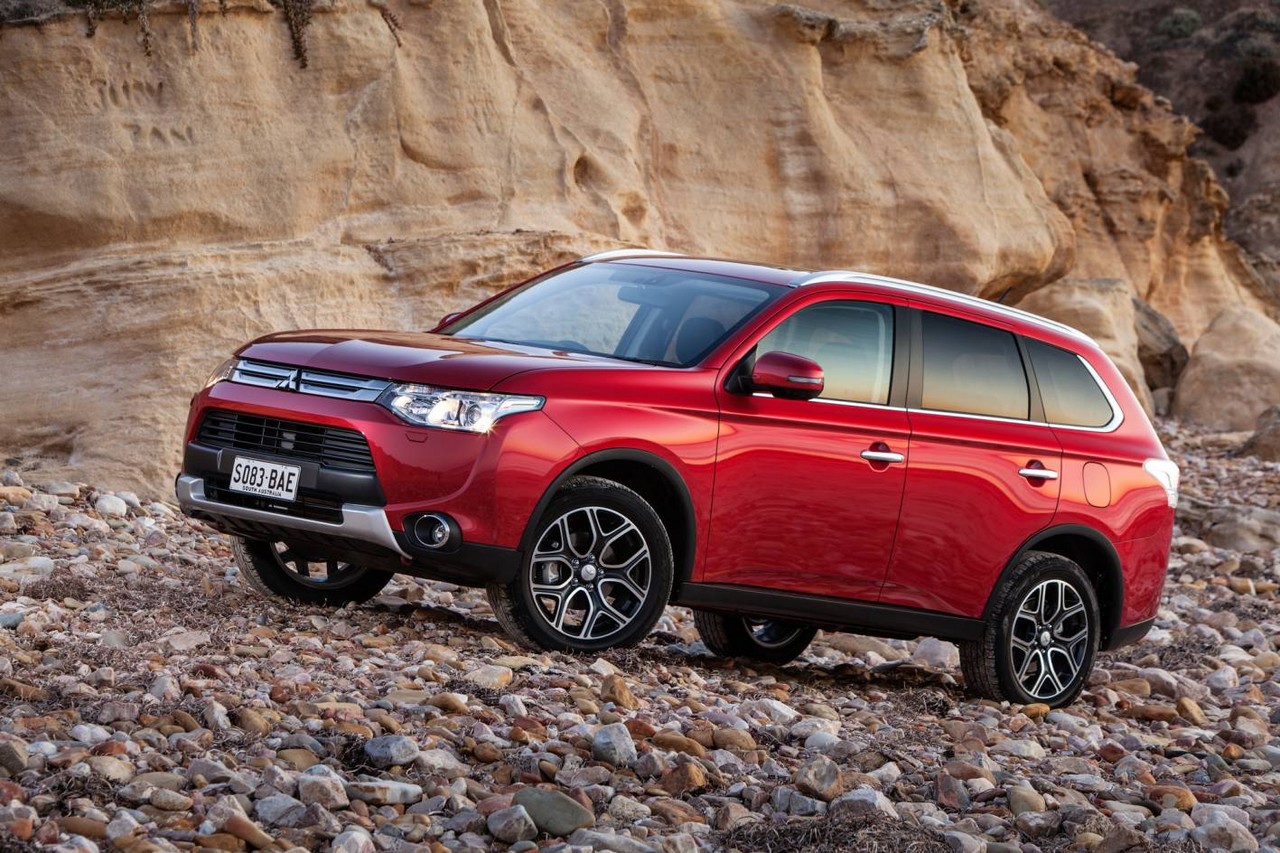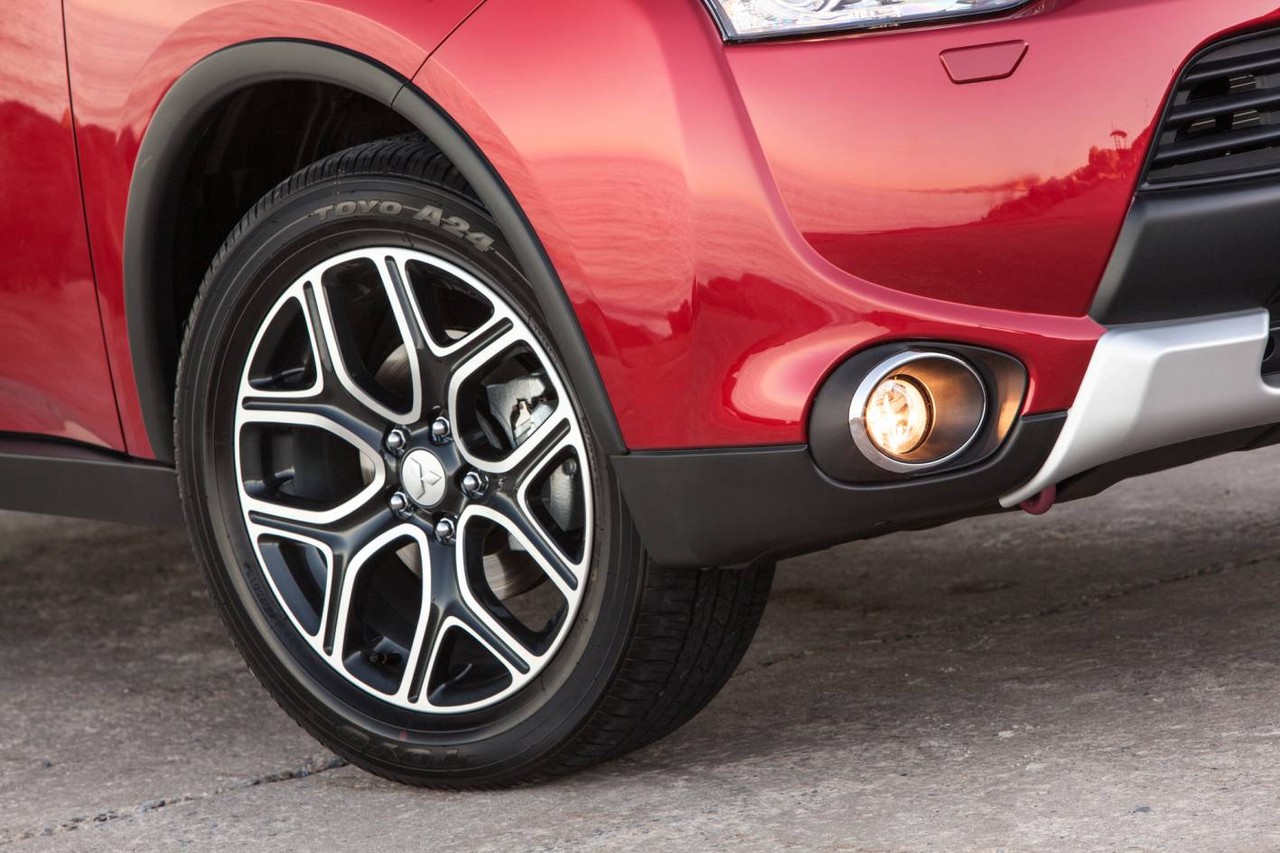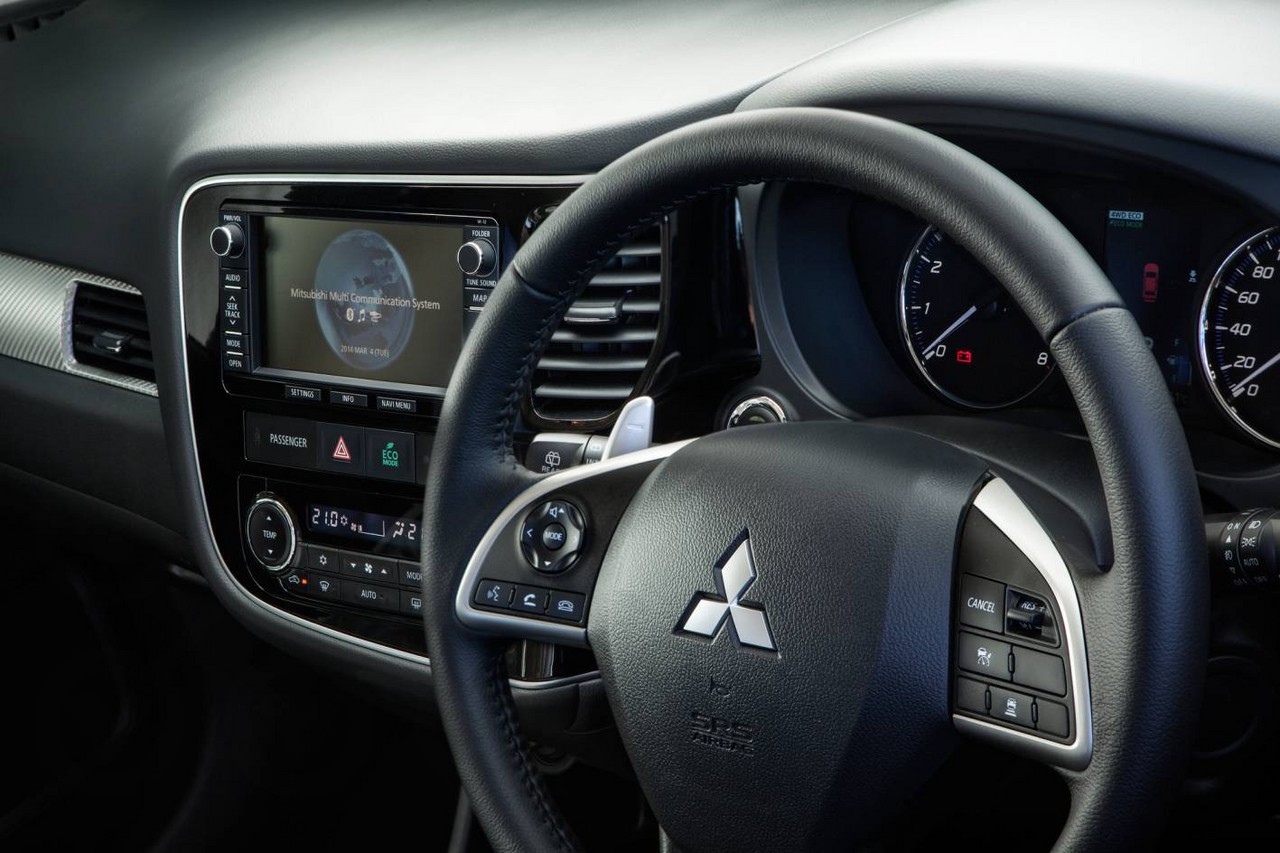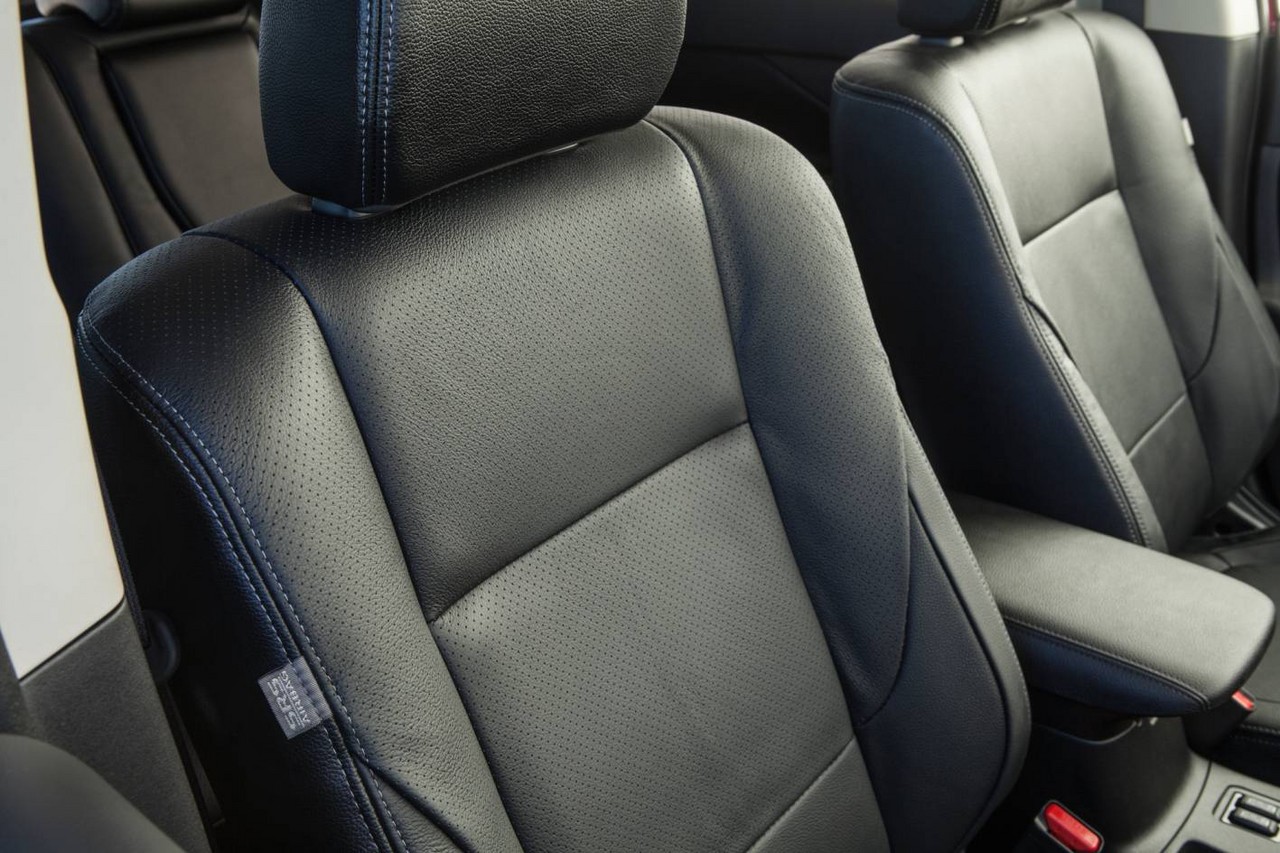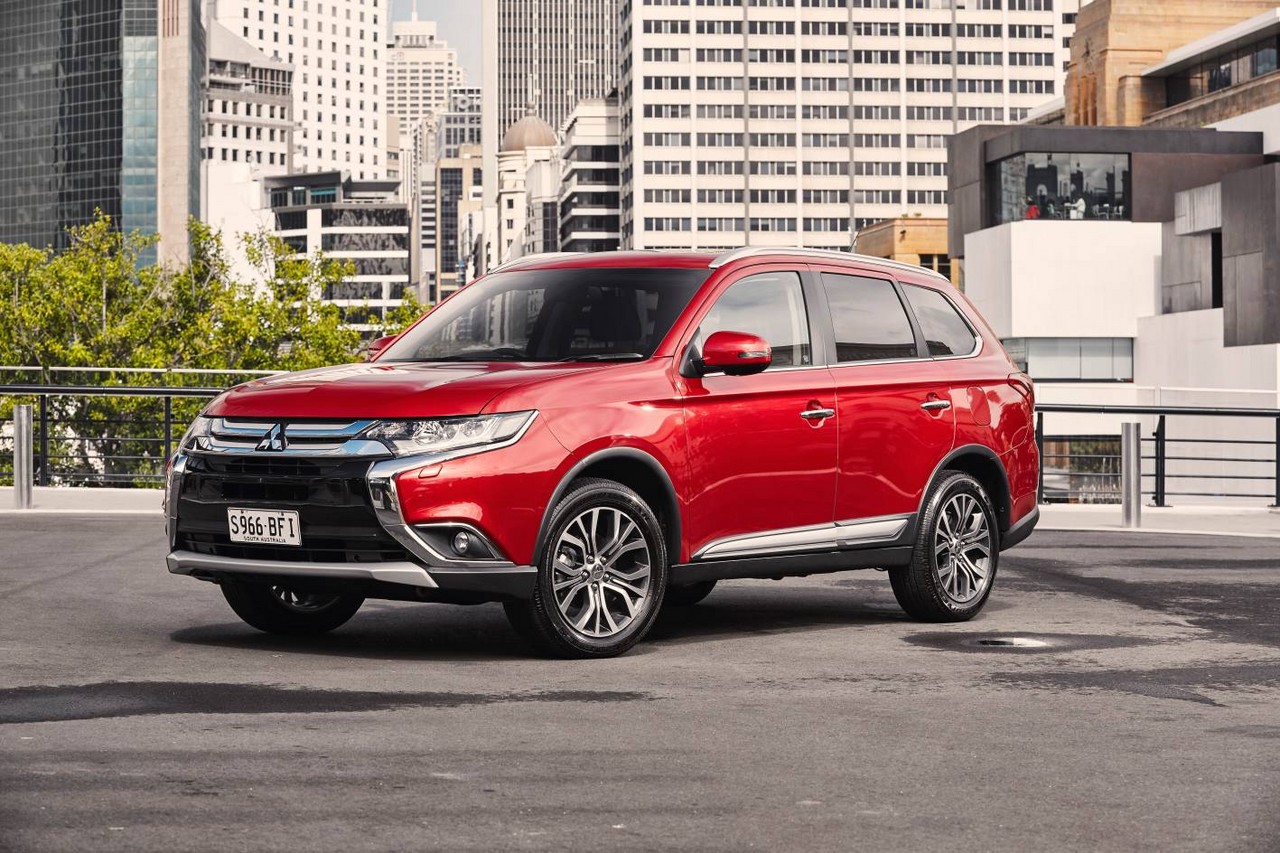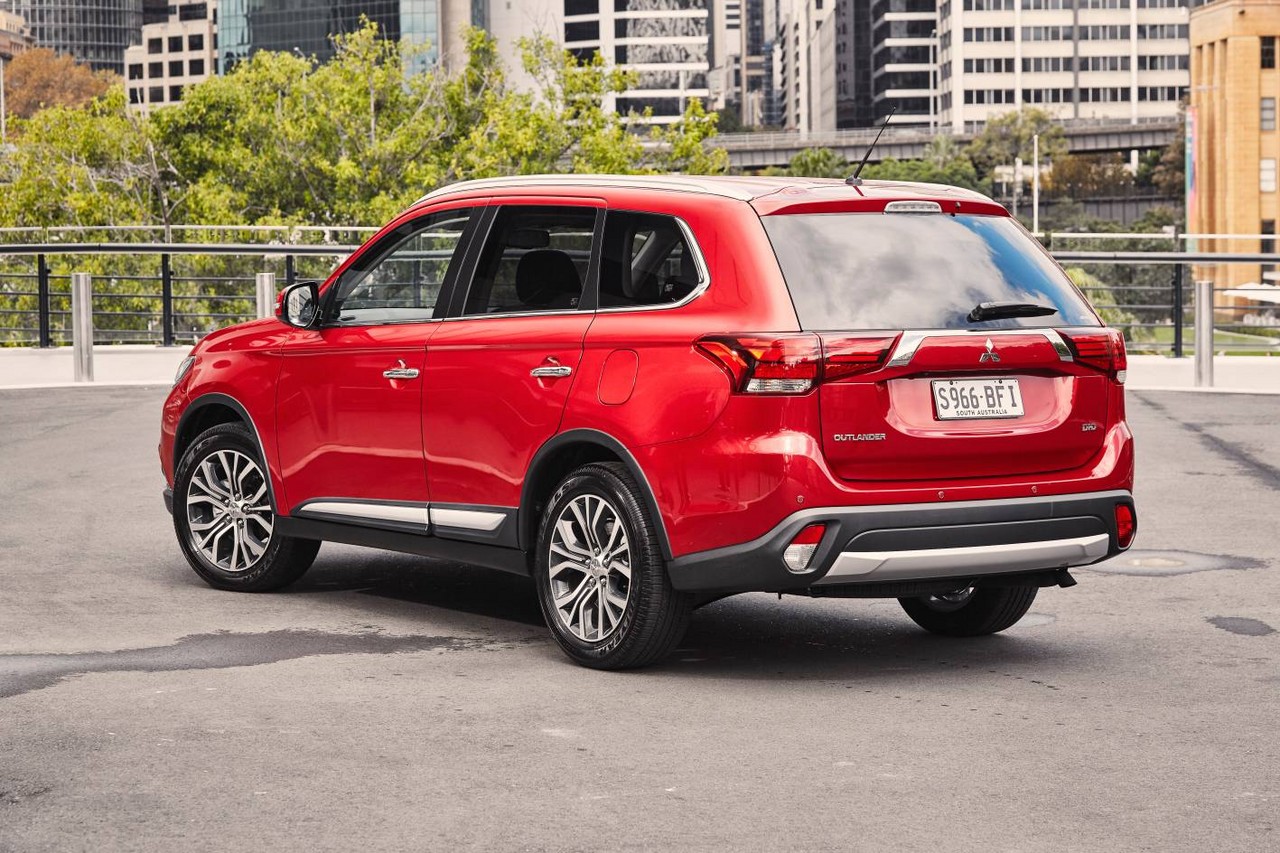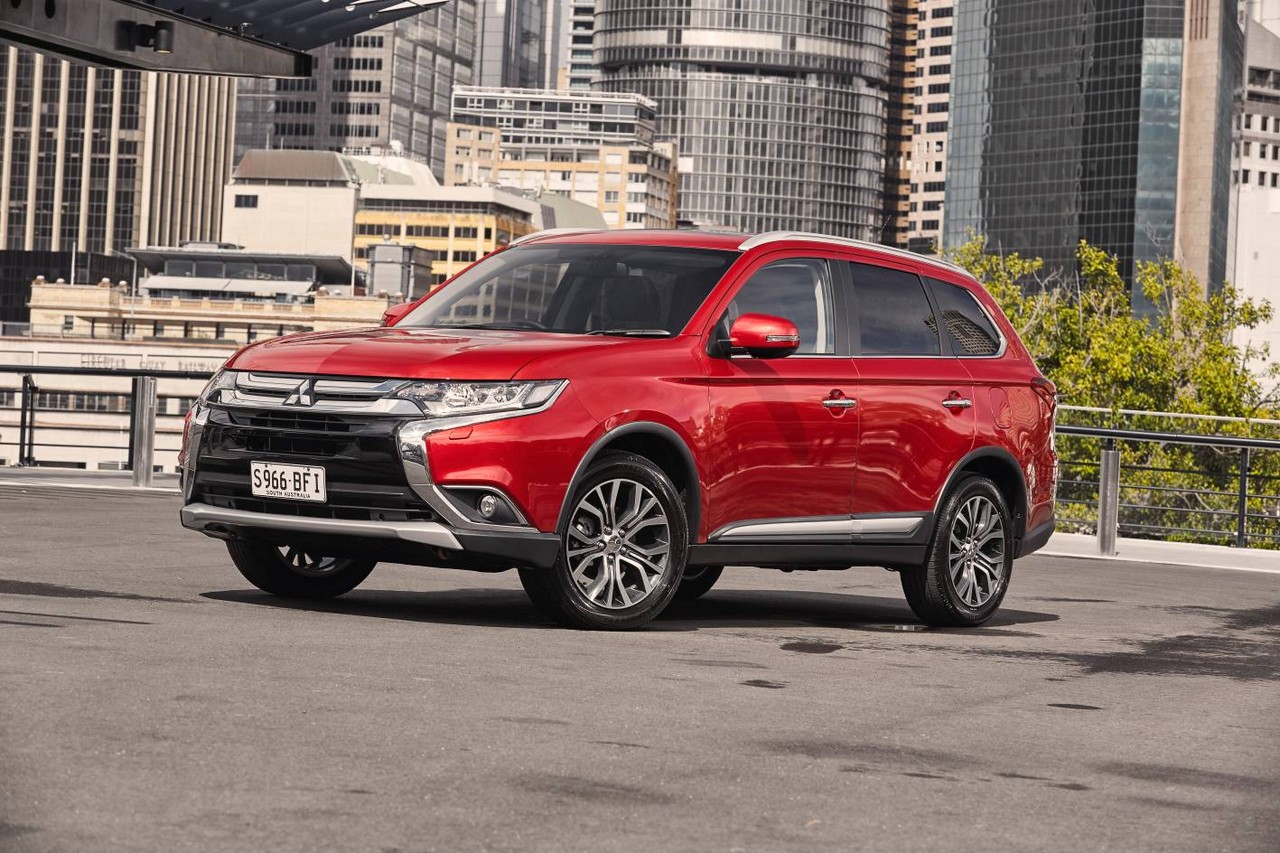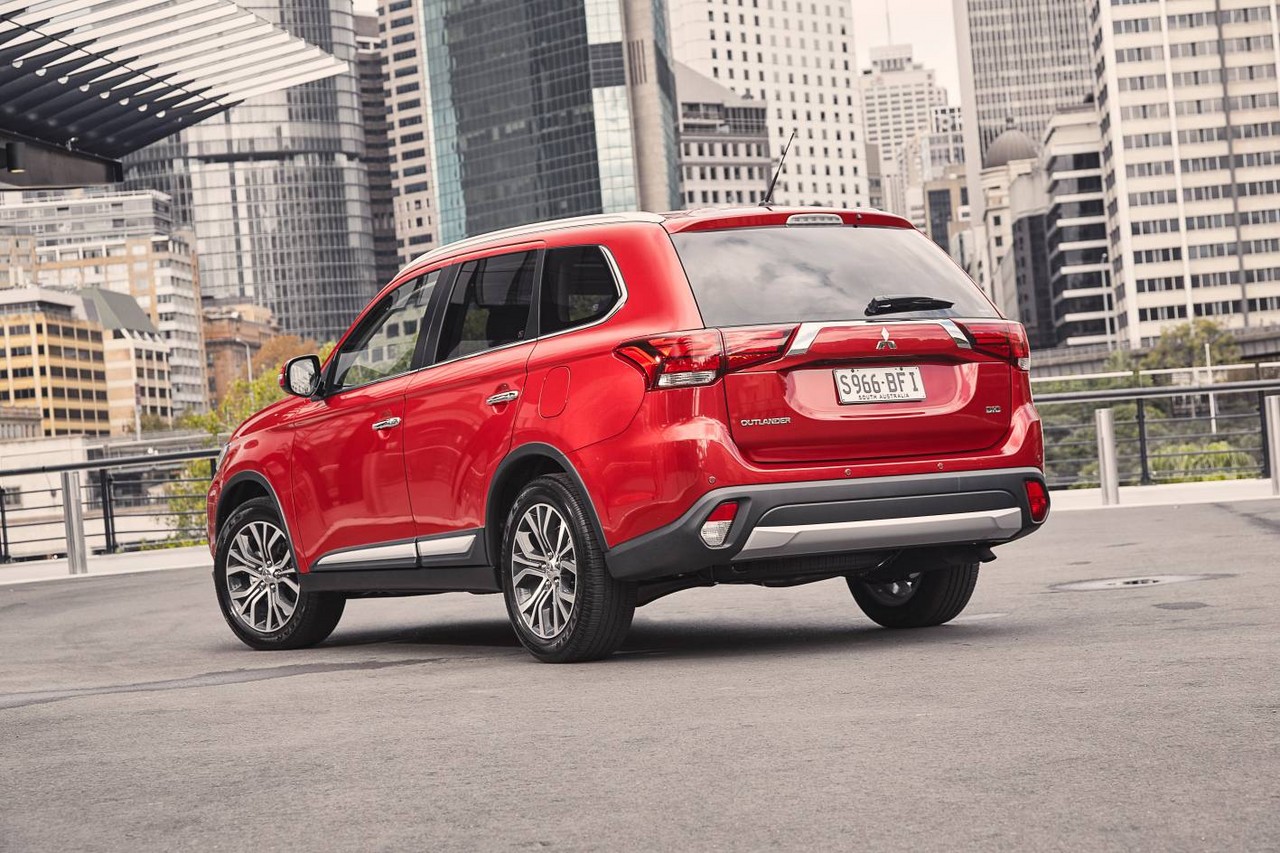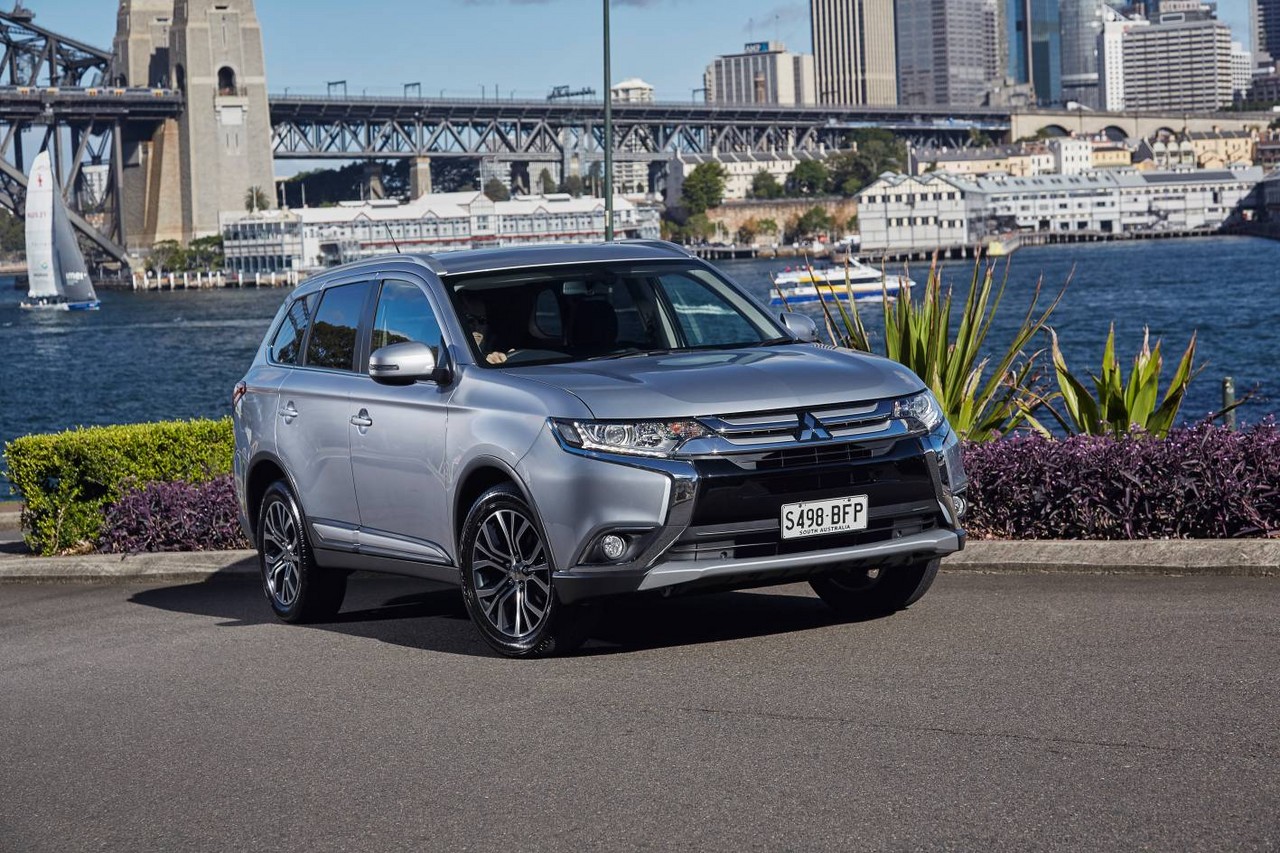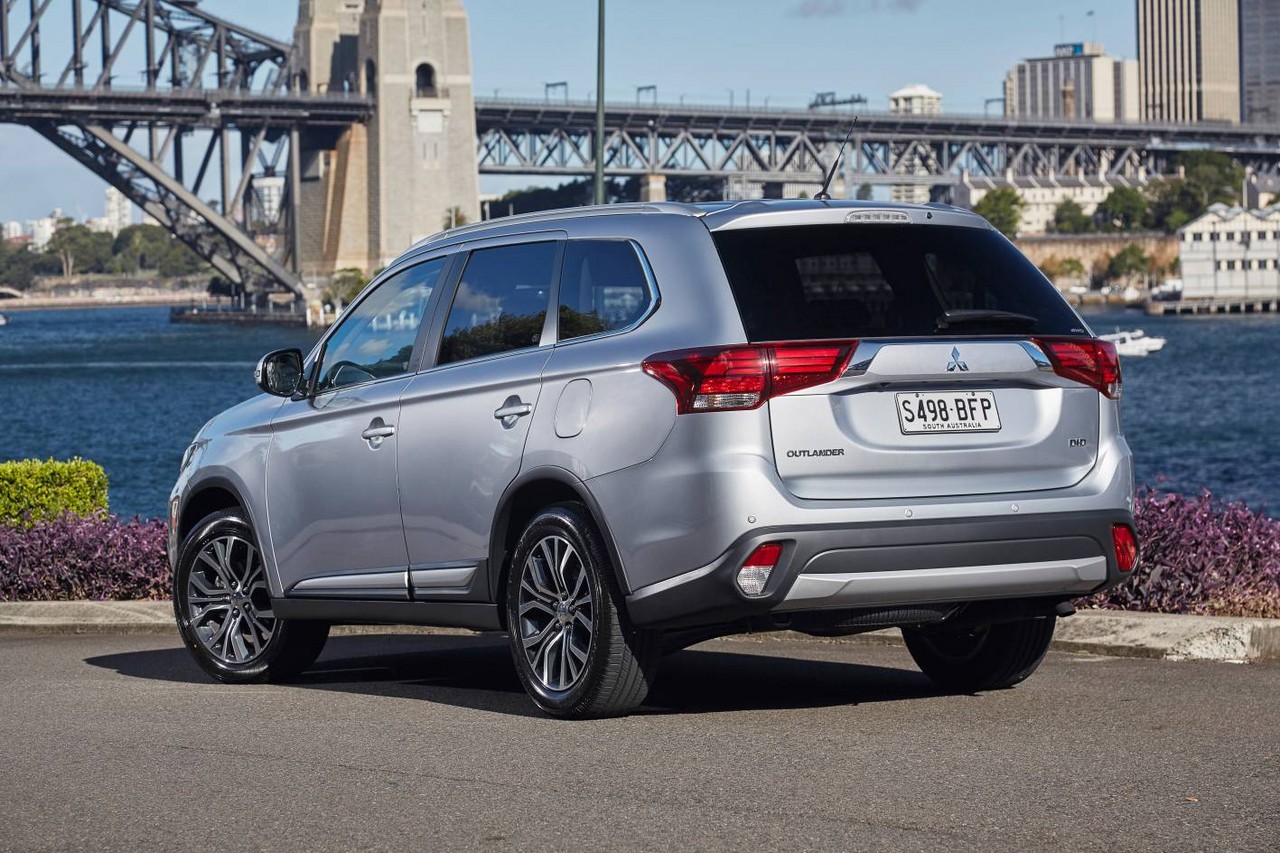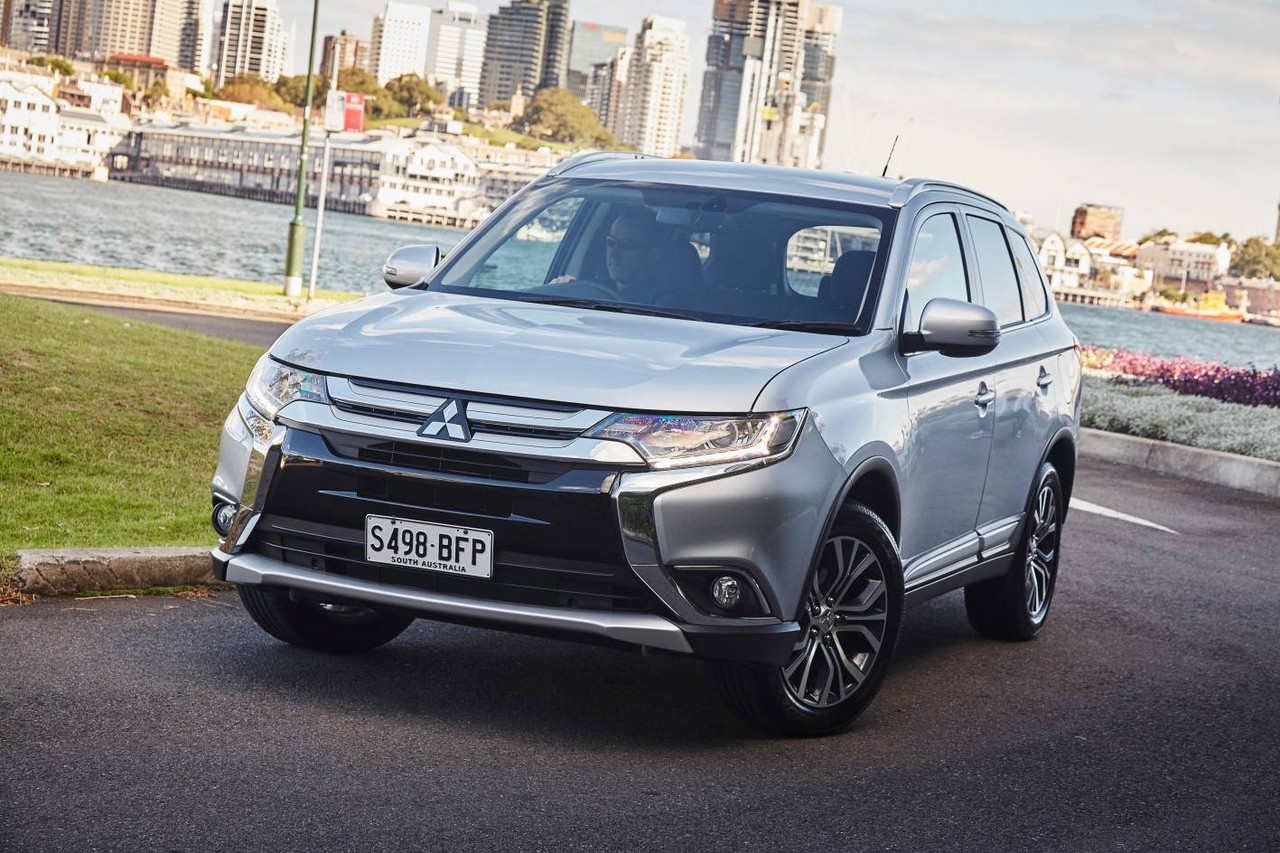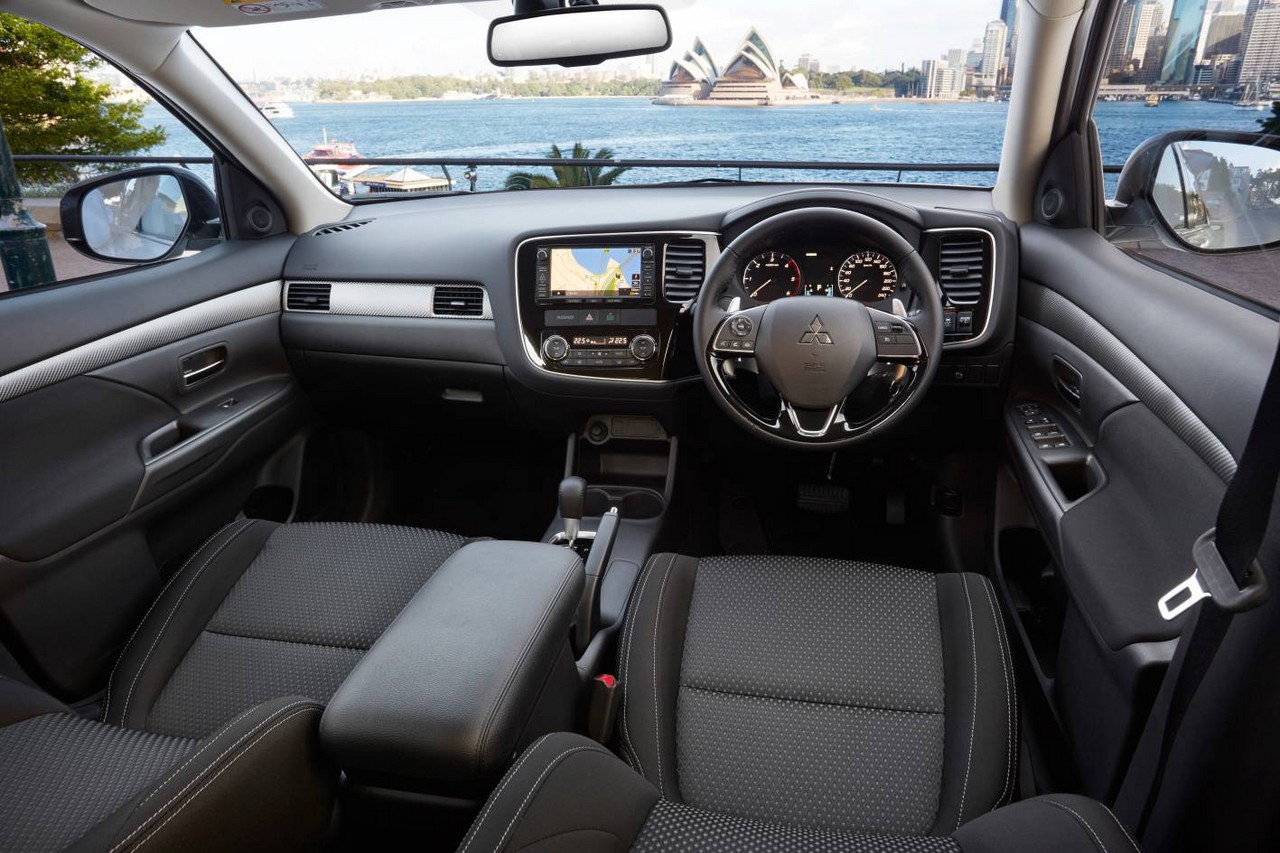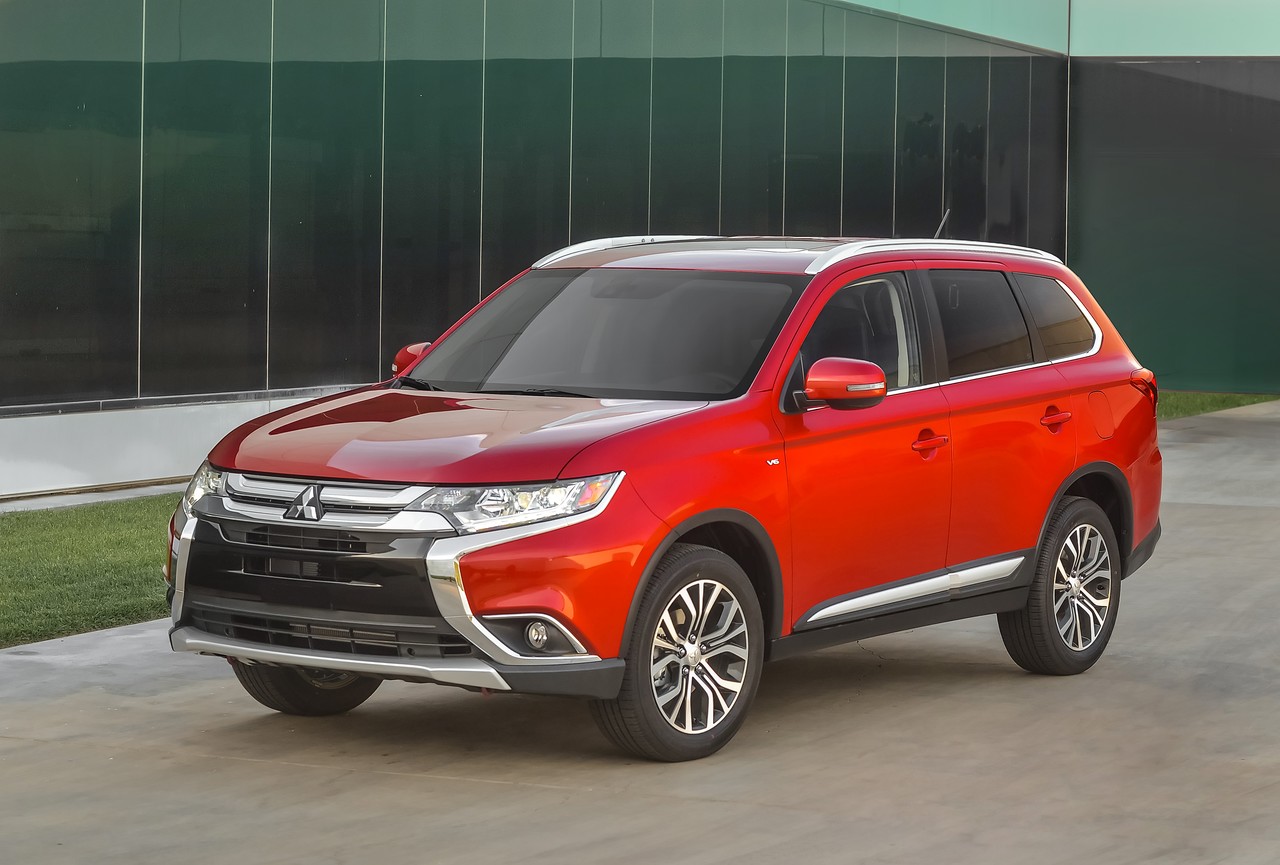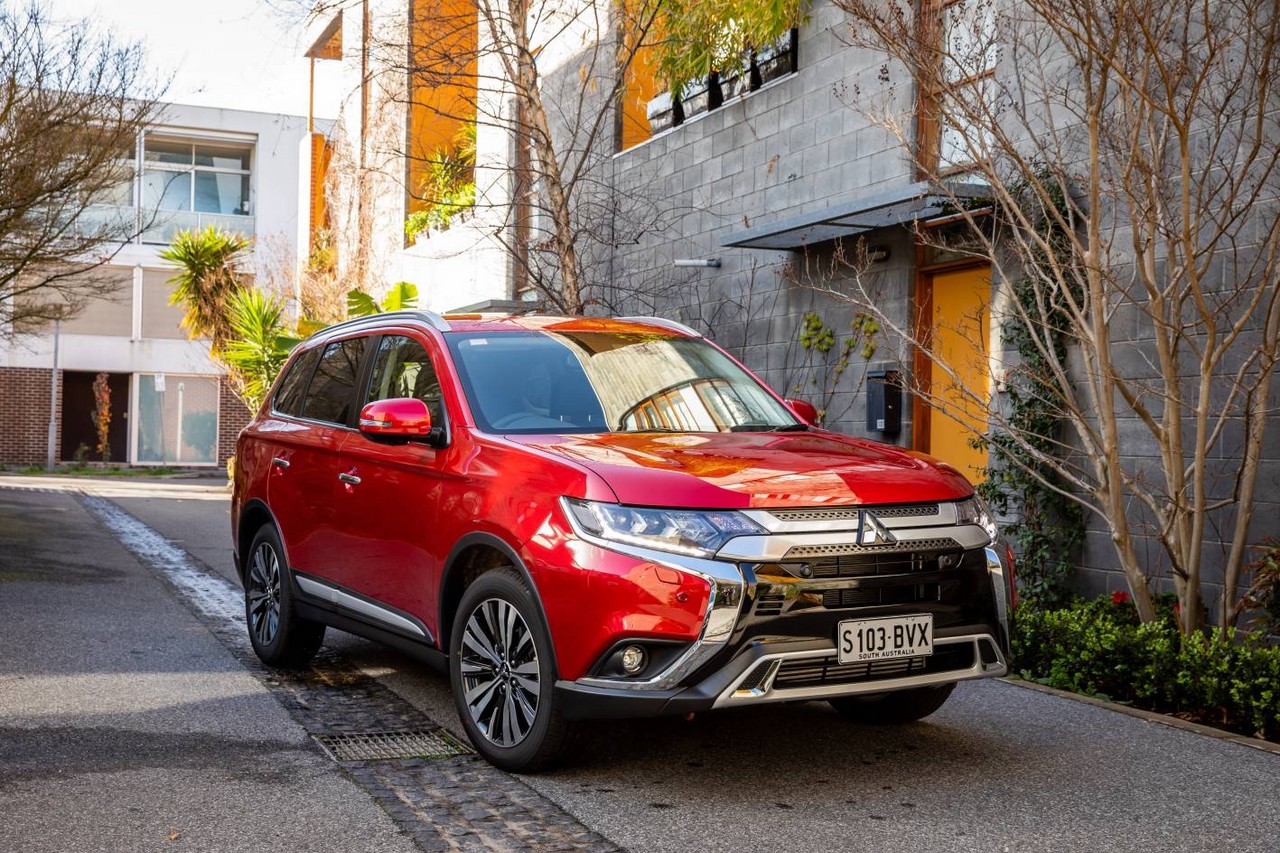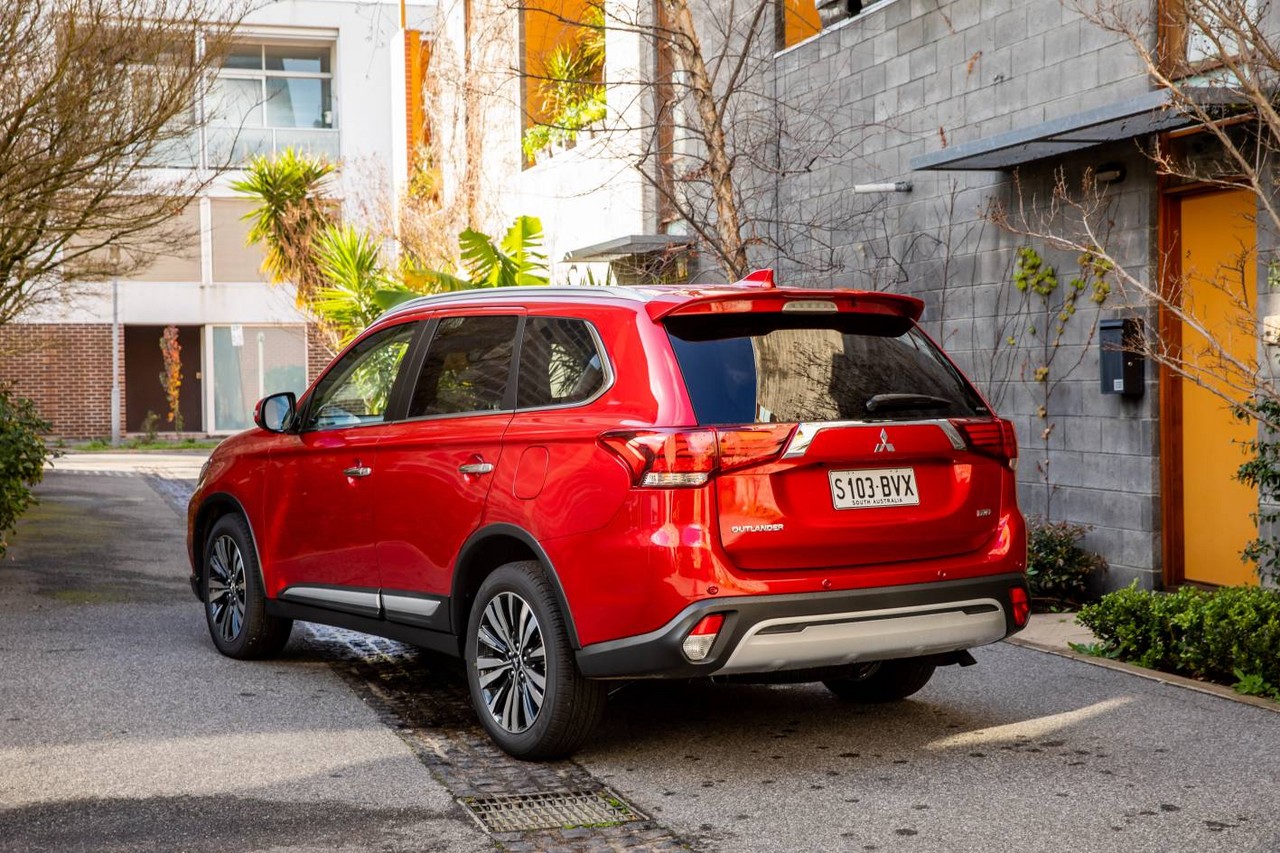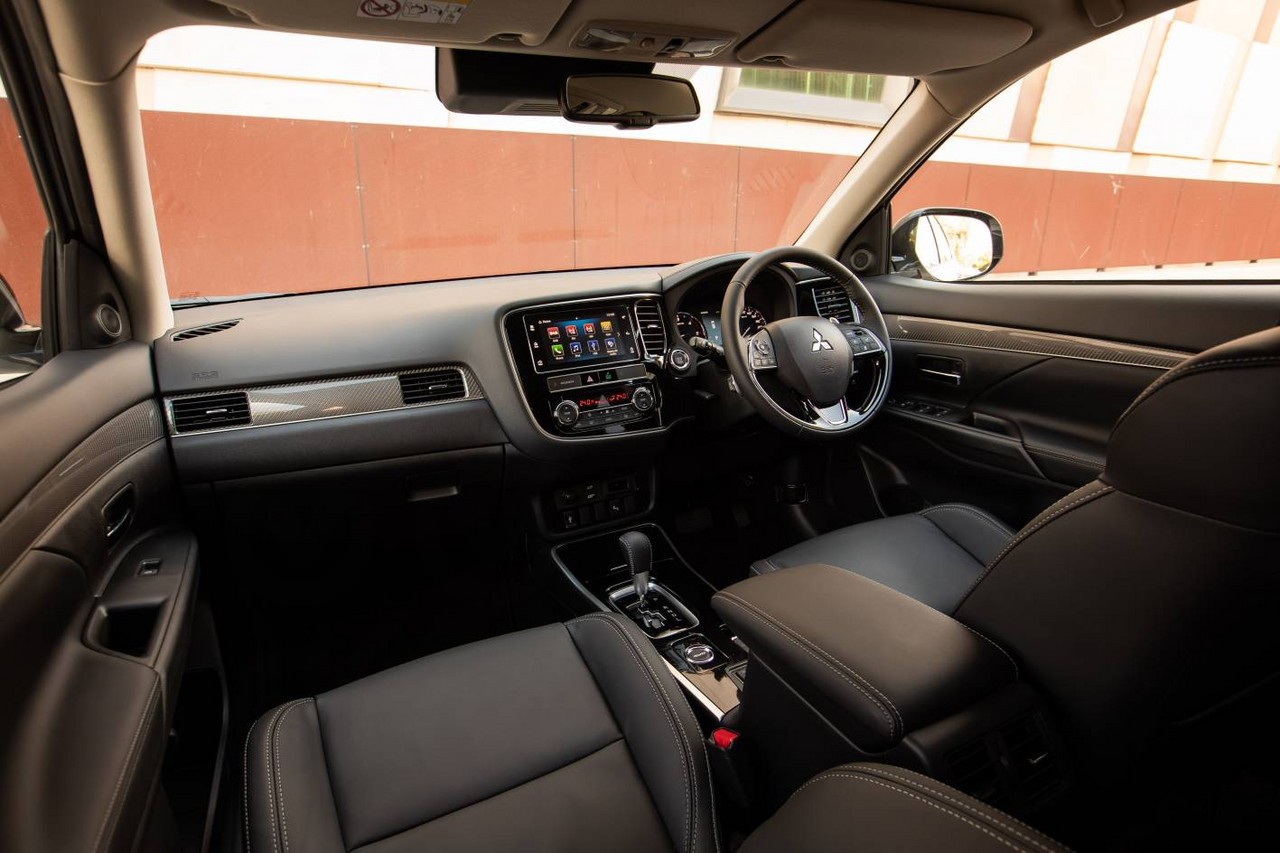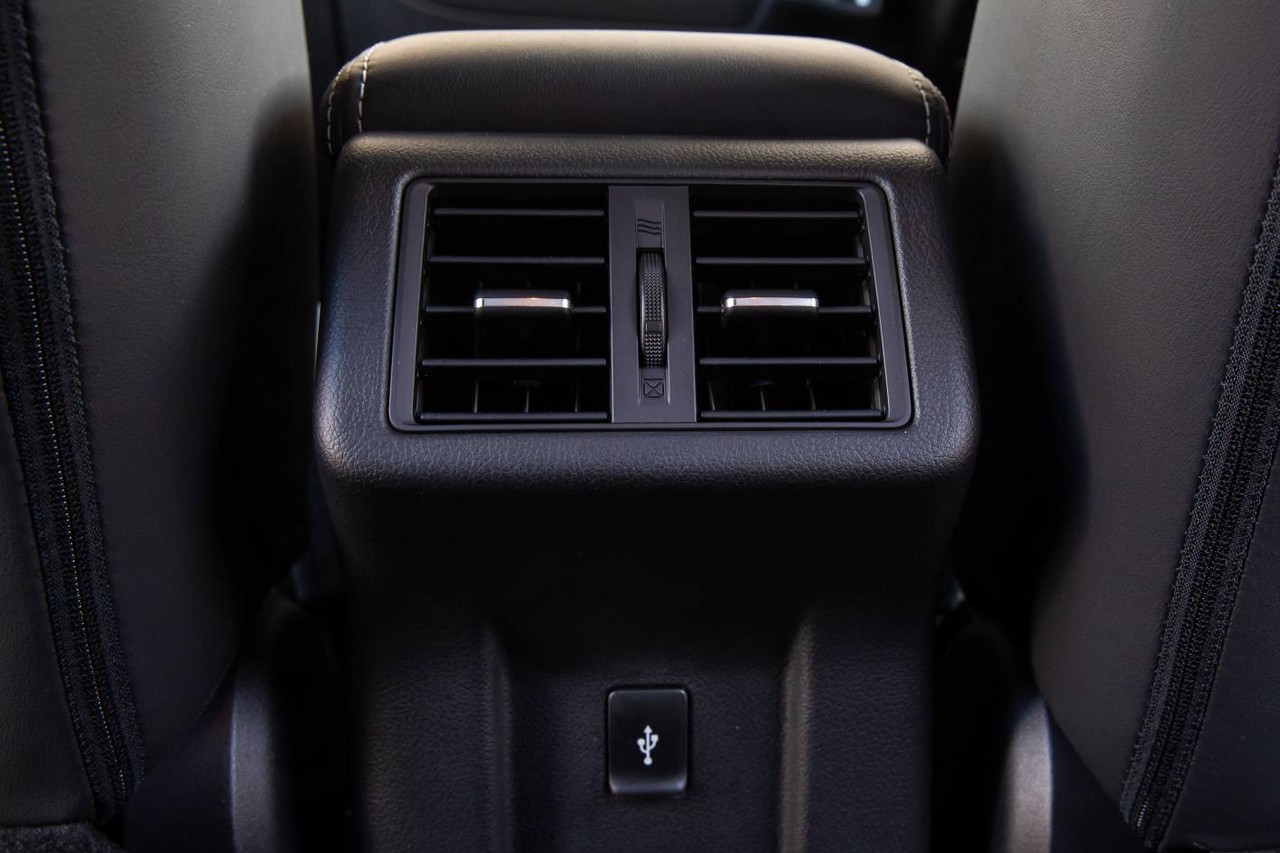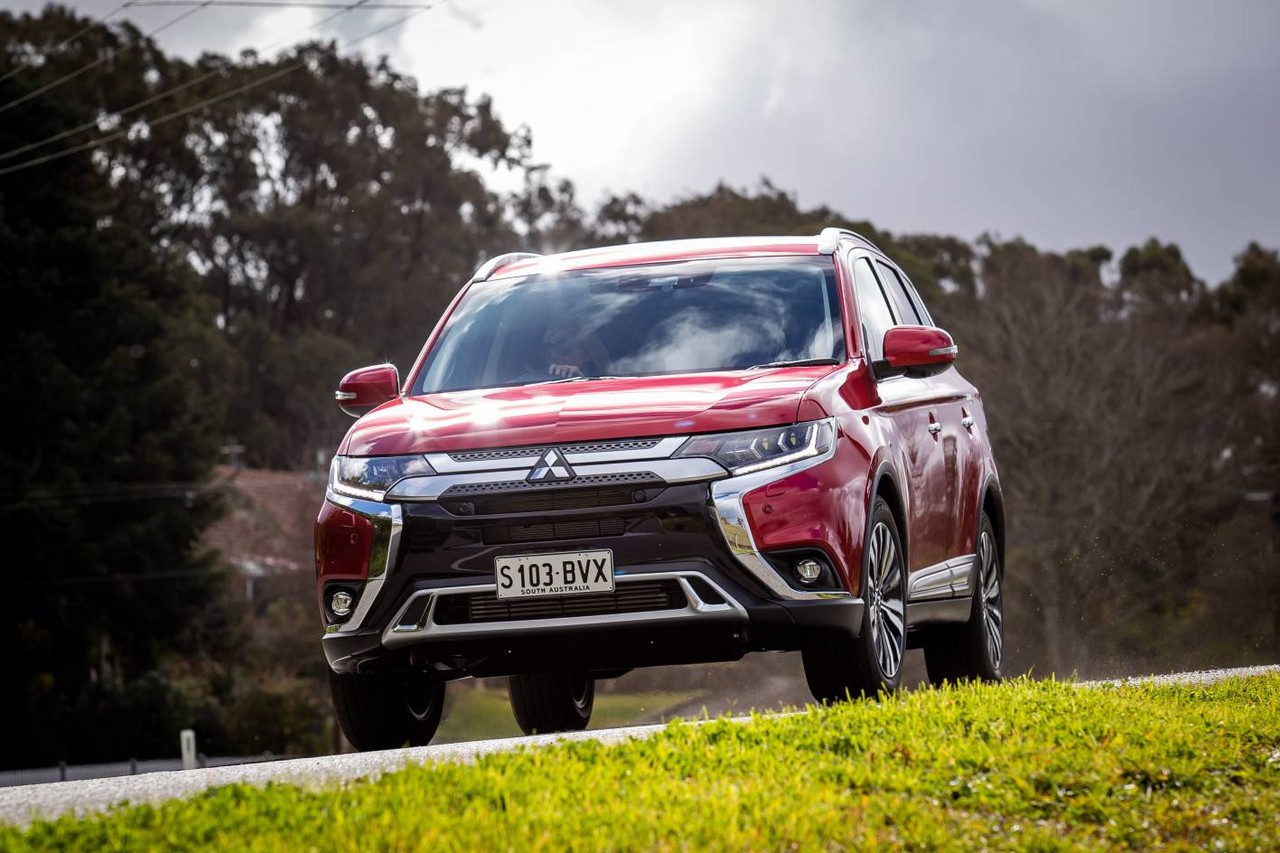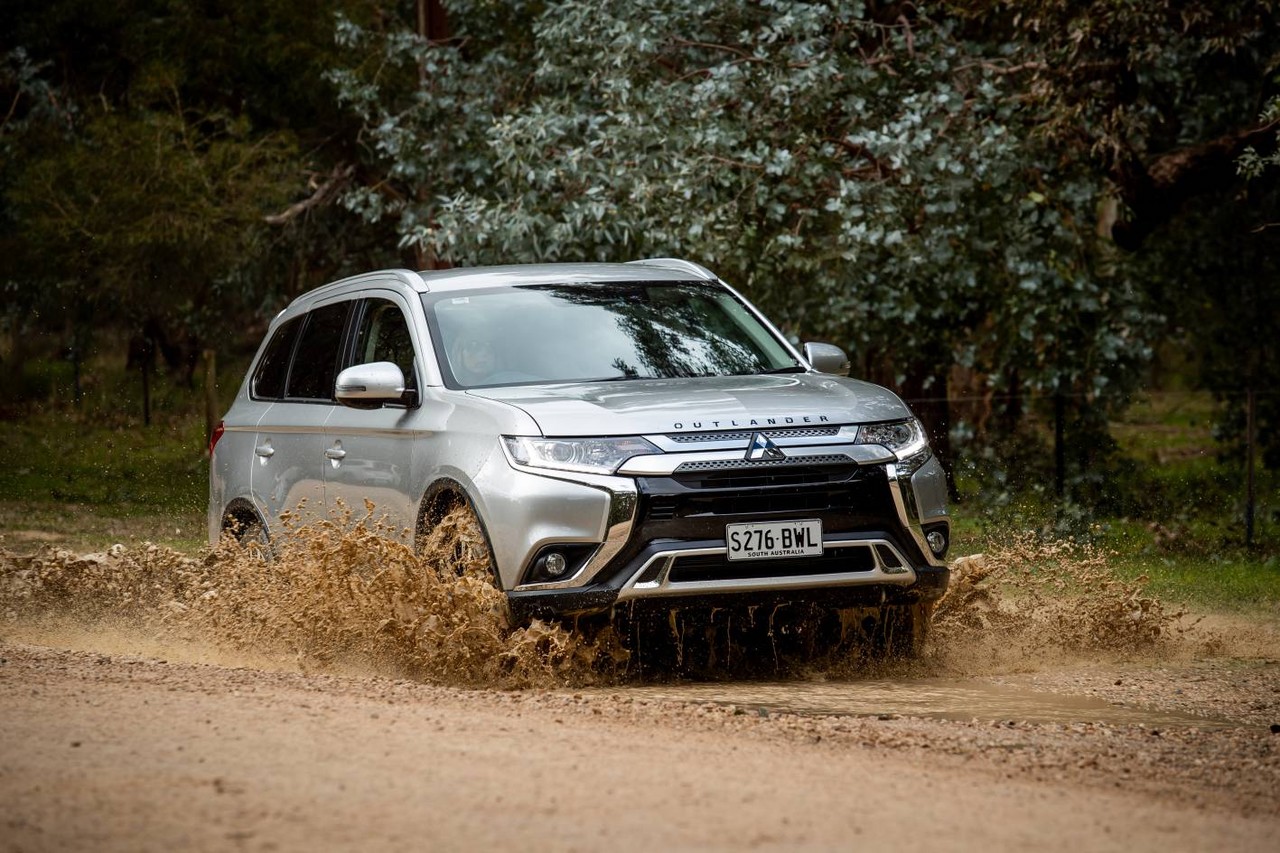
- Frugal and responsive 2.2-litre turbo-diesel engine
- Quiet, well-insulated cabin
- Comfortable ride
- Spacious interior
- Underpowered 2.0-litre petrol engine
- Where fitted, droning noise from CVT
- Body roll when cornering
- Inconsistently weighted electric steering
- For diesel engine, driveline vibrations
Review: Mitsubishi ZJ.I Outlander (2012-14)
Overview
Released in November 2012, the Mitsubishi ZJ Series I (ZJ.I) Outlander was a mid-size SUV. Manufactured in Japan, the Mk.3 Outlander was initially available with 2.0- and 2.4-litre MIVEC petrol engines and a 2.0-litre turbo-diesel engine. All models, however, had an ‘ECO’ drive mode which adjusted throttle response, air conditioning and four-wheel drive systems to conserve fuel.
Compared to its ZG/ZH Outlander predecessor, the Mk.3 Outlander was 15 mm longer (at 4655 mm) and 60 mm lower (1680 mm), though width (1800 mm) and wheelbase length (2670 mm) were unchanged. Furthermore, the Mk.3 Outlander had a stronger body due to its high-tensile strength paneling and improved aerodynamics. The Mk.3 Outlander had MacPherson strut front suspension and independent, multi-link rear suspension.
| Engine | Drive | Variant | Trans. | Seats | Peak power | Peak torque |
|---|---|---|---|---|---|---|
| 2.0-litre petrol I4 |
FWD | ES | 5sp man. | 5 | 110 kW at 6000 rpm | 190 Nm at 4200 rpm |
| ES | CVT | 5 | ||||
| LS | CVT | 5 | ||||
| 2.4-litre petrol I4 |
AWD | ES | CVT | 5 | 124 kW at 6000 rpm | 220 Nm at 4200 rpm |
| LS | CVT | 7 | ||||
| Aspire | CVT | 7 | ||||
| 2.2-litre turbo-diesel I4 | AWD | LS | 6sp auto | 7 | 110 kW at 3500 rpm | 360 Nm at 1500-2750 rpm |
| Aspire | 6sp auto | 7 |
AWD system
The Outlander was fitted with ‘Mitsubishi’s Super All Wheel Control’ (S-AWC) all-wheel drive system which consisted of an active front limited-slip differential and an electronically-controlled four-wheel drive coupling. The S-AWC system provided three selectable drive modes –
- 4WD ECO: front-wheel drive in normal conditions, though four-wheel drive would be engaged in slippery conditions;
- 4WD Auto: all-wheel drive would engage for road conditions such as dry asphalt roads, wet roads and snowy roads; and,
- 4WD Lock: provided permanent four-wheel drive with a 50:50 front/rear torque split.
Safety equipment
Standard safety equipment for the ZJ.I Outlander included dual front airbags, a driver’s knee airbag, front side airbags, full-length curtain airbags, ABS, electronic brake force distribution, brake assist, electronic stability control, traction control and front seatbelts with pretensioners and load limiters.
Initially, the Aspire variants were offered with an optional extra-cost ‘Premium Pack’ which included:
- Forward Collision Mitigation (FCM) which detected obstacles on the road ahead of the vehicle and would automatically apply the brakes to prevent a collision; and,
- Adaptive Cruise Control (ACC) which maintained a safe distance from the vehicle in front, even at low speeds in traffic.
From September 2013, however, the Aspire was fitted with FCM and ACC as standard.
Euro NCAP testing
In Euro NCAP testing , a ZJ Outlander received a five star safety rating which included a 94 per cent adult occupant protection rating and an 83 per cent child occupant protection rating. In the front offset crash test, protection of the front occupants’ chests and lower legs was rated as adequate (rather than the maximum ‘good’ rating), while foot protection for the driver was also rated as adequate. Maximum points were awarded in the side impact test; in the more severe pole, test, however, chest protection was assessed as marginal and abdominal protection as adequate. Under ANCAP’s methodology , this testing resulted in a five star adult occupant protection rating with a score of 35.58 out of 37.
Features: Outlander ES, LS and Aspire
Standard features for the Mitsuibshi Outlander ES included 16-inch steel wheels, a six speaker sound system with a CD player, Bluetooth connectivity, climate control air conditioning, rear parking sensors, a leather-wrapped steering wheel and gearshift knob, 60/40 split and flat folding rear seats, remote central locking, power windows and mirrors, power folding mirrors, tilt and telescopic steering wheel adjustment, a trip computer and an immobiliser.
The Outlander LS was further equipped with 16-inch alloy wheels, dual-zone climate control air conditioning, a 6.1-inch colour touch screen, reversing camera with reverse parking guidelines, front fog lights and rear privacy glass.
The range-topping Outlander Aspire was distinguished by its 18-inch alloy wheels, leather seats, heated front seats, a power adjustable driver’s seat, automatic headlights, rain-sensing wipers, wood print interior accents, outer scuff plates and chrome accents on the belt-line mouldings and door handles.
With respect to features, the aforementioned ‘Premium Pack’ included a Rockford Fosgate sound system with nine speakers and a ten-inch subwoofer and the Mitsubishi Multi Communication System (MMCS) with a seven-inch colour display.
September 2013: Outlander update
In September 2013, standard features for teh Mitsubishi Outlander were extended to include 18-inch alloy wheels and black roof rails. Furthermore, standard features for ES variants were extended to include a 6.1-inch colour touch screen and a reversing camera with reverse parking guidelines.
Mitsubishi Outlander LS variants gained automatic headlights and rain-sensing wipers, while both the LS and Aspire variants were fitted with the Mitsubishi Multi Communication System (MMCS) which included satellite navigation (with 3D maps), a seven-inch touch screen and SD card input. Finally, the Aspire variants were further equipped with high-intensity display headlights, a power sunroof and power-operated tailgate.
Related links
- Brochure: Mitsubishi ZJ Outlander (August 2013)
- Mitsubishi News: Mitsubishi Motors’ Next-Generation Outstanding Outlander (October 2012)
Review: Mitsubishi ZJ.II Outlander (2014-15)
Overview
Released in March 2014, the ZJ Series II (ZJ.II) Outlander introduced a subtle facelift and other upgrades. Visually, the ZJ.II Outlander could be identified by its more prominent upper bumper, twin-blade horizontal upper grille, black gloss-finished main grille, silver rear skid plate, black wheel arches and silver roof rails. Aspire variants were also fitted with ten-spoke machine-faced alloy wheels and LED tail-lights.
Other changes for the ZJ.II Outlander included:
- Retuned shock absorbers and dampers;
- A new spring mount isolator for improved roll control;
- For models with 2.0- and 2.4-litre petrol engines, improved sound insulation; and
- Upgraded continuously variable transmissions (CVTs) with improved launch feel.
| Engine | Drive | Variant | Trans. | Seats | Peak power | Peak torque |
|---|---|---|---|---|---|---|
| 2.0-litre petrol I4 |
FWD | ES | 5sp man. | 5 | 110 kW at 6000 rpm | 190 Nm at 4200 rpm |
| ES | CVT | 5 | ||||
| LS | CVT | 5 | ||||
| 2.4-litre petrol I4 |
AWD | ES | CVT | 5 | 124 kW at 6000 rpm | 220 Nm at 4200 rpm |
| LS | CVT | 7 | ||||
| Aspire | CVT | 7 | ||||
| 2.2-litre turbo-diesel I4 | AWD | LS | 6sp auto | 7 | 110 kW at 3500 rpm | 360 Nm at 1500-2750 rpm |
| Aspire | 6sp auto | 7 |
Safety equipment
Compared to its ZJ predecessor, standard safety equipment for the ZJ.II Outlander was extended to include an Emergency Stop Signal (ESS) which flashed the hazard warning lights when heavy braking occurred to alert vehicles approaching from behind.
Features
Standard features for the ZJ.II Outlander were extended to include front fog lights (previously omitted from ES variants). Furthermore, Outlander LS variants had new black cloth seat trims with leather inserts and chrome door handles, while Aspire variants were fitted with a textured silver garnish across the instrument panel and front doors.
Brochure
Related links
Review: Mitsubishi ZK Outlander (2015-18)
Overview
Released in Australia in April 2015, the Mitsubishi ZK Outlander introduced new styling and interior upgrades. As per the table below, the range was revised to consist of LS, XLS and Exceed variants. While the LS variants had five seats, the XLS and Exceed variants had seven seats.
Changes for the ZK Outlander included:
- A more rigid body and suspension due to reinforcements and bracing added to the front firewall, front top cowl, rear subframe and rear wheel house;
- Re-tuned, ‘dynamic’ dampers front and rear for greater improved ride quality;
- A new calibration for the electric power-assisted stering;
- A ‘new generation’ continuously variable transmission (CVT) for better shift feel and torque delivery; and,
- For greater refinement, noise-isolating windscreen and tailgate glass, additional sound insulation and new rear differential dampers.
Visually, the ZK Outlander could be identified by Mitsubishi’s ‘Dynamic Shield’ design concept which included an aggressive front fascia and redesigned front bumpers, headlights, LED position lights, lower door sections and alloy wheels. At the rear, there was a new rear fascia and LED tail-lights.
| Engine | Drive | Variant | Trans. | Seats | Peak power | Peak torque |
|---|---|---|---|---|---|---|
| 2.0-litre petrol I4 |
FWD | LS | 5sp man. | 5 | 110 kW at 6000 rpm | 190 Nm at 4200 rpm |
| CVT | 5, 7 (from 2016) |
|||||
| XLS | CVT | 5 | ||||
| 2.4-litre petrol I4 |
AWD | LS | CVT | 5 | 124 kW at 6000 rpm | 220 Nm at 4200 rpm |
| XLS, Exceed |
CVT | 7 | ||||
| 2.2-litre turbo-diesel I4 | AWD | XLS, Exceed |
6sp auto | 7 | 110 kW at 3500 rpm | 360 Nm at 1500-2750 rpm |
Safety equipment
Compared to the Mitsubishi ZJ.II Outlander, standard safety equipment for the ZK Outlander was initially unchanged. Unique within the range, however, the Outlander Exceed was fitted with Forward Collision Mitigation and Adaptive Cruise Control.
From September 2016,
- The newly introduced Outlander LS Safety Pack was equipped with Forward Collision Mitigation, Lane Departure Warning, Adaptive Cruise Control and automatic high beam headlights; and,
- The Outlander Exceed gained Mitsubishi’s Multi Around Monitor, a Blind Spot Warning system, Rear Cross Traffic Alert, Lane Change Assist and automatic high beam headlights.
Features: Outlander LS, XLS and Exceed
Standard features for the Mitsubishi ZK Outlander LS included 18-inch alloy wheels with 225/55 R18 98H tyres, a six speaker sound system with a 6.1-inch colour touchscreen, a CD player and auxiliary inputs (3.5 mm/USB/iPod), Bluetooth mobile phone connectivity and audio streaming, climate control air conditioning, cruise control, cloth seat trim, front and rear fog lamps, LED daytime running lights, a rear view camera, rear parking sensors, 60/40 split and folding second row seats, a leather-wrapped steering wheel and gearshift lever, remote central locking, power windows and mirrors, tilt and telescopic steering column adjustment, a height adjustable driver’s seat, 12 volt power socket, rear privacy glass, silver roof rails, a trip computer, an alarm and immobiliser.
Features: Outlander XLS
Compared to the Outlander LS, the Outlander XLS was further equipped with the Mitsubishi Multi Communication System (MMCS) which included navigation, a seven-inch touchscreen and SD card input, a digital radio tuner (DAB), dual-zone climate control air conditioning, automatic headlights, rain-sensing wipers, 50/50 split third row seats, power folding mirrors with heating function, an electrochromatic rear view mirror and cargo blind.
Features: Outlander Exceed
The range-topping Mitsubishi Outlander Exceed was distinguished by its leather seat facings, power adjustable and heated front seats, LED headlights with washers, a proximity key for keyless entry and push-button start, (Mitsubishi’s ‘Smart Key’), power-operated sunroof, power-operated tailgate, scuff plates and piano black interior trim.
September 2016 update
From September 2016, all ZK Outlander models were equipped with Mitsubishi’s Smartphone Link Display Audio (SDA), a digital radio tuner (DAB), LED footwell lighting, a new LED-lit centre console box and a 12 volt power socket in the rear cargo area. For all-wheel drive Outlander models, an electric park brake was also fitted as standard.
According to Mitsubishi, the suspension was revised ‘to enhance overall ride comfort and stability’, with:
- New shock valves to ‘advance linearity and body control’;
- Lower friction front struts with revised damping for ‘improved steering linearity’;
- Revised rear shock absorbers to ‘boost stability and ride comfort’ and,
- New rear toe link bushes ‘for improved lateral rigidity’.
Specifications
Brochures
Review: Mitsubishi ZL Outlander (2018-21)
Overview
Officially released in Australia in August 2018, the Mitsubishi ZL Outlander introduced styling, interior and mechanical upgrades. As per the table below, the ZL Outlander range was powered by 2.0- and 2.4-litre petrol engines and 2.2-litre turbo-diesel engines, and consisted of ES, ES ADAS, LS and Exceed variants.
Visually, the Mitsubishi ZL Outlander could be identified by its twin-blade grille, new bumpers and new 18-inch alloy wheel design. The Outlander LS and Exceed variants were also fitted with a new rear spoiler which was claimed to provide improved aerodynamics and reduce wind noise.
Inside, the Mitsubishi ZL Outlander had new front seats with greater side support and new seat trims. For models with automatic and continuously variable transmissions, the centre console featured rear seat air vents and a powered USB input.
Mechanical changes for the Mitsubishi ZL Outlander included:
- ‘quick ratio’ steering for greater responsiveness and steering feel;
- Larger diameter front struts and rear shock absorbers to improve ride comfort and body control;
- New structural bonding to increase body rigidity; and,
- Changes to the exhaust manifold catalytic converter which reduced engine noise.
| Engine | Drive | Variant | Trans. | Seats | Peak power | Peak torque |
|---|---|---|---|---|---|---|
| 2.0-litre petrol I4 |
FWD | ES | 5sp man. | 5 | 110 kW at 6000 rpm | 190 Nm at 4200 rpm |
| 2.4-litre petrol I4 |
FWD | ES ADAS | CVT | 5 | 124 kW at 6000 rpm | 220 Nm at 4200 rpm |
| ES, LS |
CVT | 7 | ||||
| AWD | ES ADAS | CVT | 5 | |||
| ES, LS, Exceed |
CVT | 7 | ||||
| 2.2-litre turbo-diesel I4 | AWD | XLS, Exceed |
6sp auto | 7 | 110 kW at 3500 rpm | 360 Nm at 1500-2750 rpm |
Safety equipment
Standard safety equipment for the Mitsubishi ZL Outlander was unchanged. The ZL Outlander ES ADAS, LS and Exceed, however, were equipped with the following active safety technologies –
- Forward Collision Mitigation (FCM): used the same radar system to detect slow or stationary vehicles ahead. Initially, a warning alarm would sound, followed by autonomous application of the brakes to avoid or reduce the severity of a collision;
- Adaptive Cruise Control (ACC): used a radar system to monitor the distance to the vehicle ahead and enabled the driver to follow at one of three selectable distances. The ACC system would then regulate motive power, apply the brakes and bring the vehicle to a stop as necessary;
- Lane Departure Warning (LDW): used a camera to monitor the vehicle’s position within its lane and, if it departed from its lane without having applied the indicators, a warning tone would sound and a warning would appear on the multifunction display; and,
- Auto High Beam: when the headlights were on, Auto High Beam would automatically use the high beams when safe to do so.
The Mitsubishi ZL Outlander Exceed was also equipped with –
- Ultrasonic misacceleration Mitigation System (UMS): reduced the likelihood and severity of collisions with obstacles four metres in front or behind the vehicle by automatically applying the brakes when driver unintentionally accelerated from speeds under 10 km/h;
- Blind Spot Warning (BSW) and Lane Change Assist (LCA): provided an audible alert and displayed a blinking light in the door mirror when there was a collision risk with a vehicle that was approaching from behind that was within 3.5 metres from the Outlander PHEV’s side or 70 metres from its rear bumper;
- Mitsubishi’s Multi Around Monitor: a surround view camera system; and,
- Rear Cross Traffic Alert (RCTA): when reversing, RCTA used the rear parking sensors to detect approaching traffic that may cross the Outlander PHEV’s path and would alert the driver via a warning tone, an indicator light in the combination meter and a blinking light in the side door mirror.
Features: Mitsubishi ZL Outlander
Standard features for the Mitsubishi ZL Outlander were extended to include adjustable speed limiting with steering wheel controls, illuminated window control switches and one-touch power window operation from the driver’s door for all windows.
For the Mitsubishi ZL Outlander LS, standard features were extended to include four-way power seat adjustment, and ‘leather-look’ seat and door trim inserts. Furthermore, the ZL Outlander LS and Outlander Exceed gained updated interior trims and a rear spoiler.
For a complete list of features, please refer to the brochure below.
August 2019 update (’20MY’)
In August 2019, the Mitsubishi ZL Outlander range was updated –
- For safety equipment, Forward Collision Mitigation was made standard across the range;
- Standard features were extended to include power lumbar adjustment for the driver’s seat, rain-sensing wipers, dusk-sensing headlamps and an auto-dimming rear-view mirror;
- The updated infotainment system – which was standard across the range – had an eight-inch touchscreen; and,
- For the Outlander Exceed, standard features were extended to include a TomTom satellite navigation system, while the Super All Wheel Control (S-AWC) all-wheel drive system enabled the driver to engage a newly introduced ‘Gravel’ drive mode.
Other changes included improved heating, ventilation and air conditioning (HVAC) controls, a new overhead console (with sunglasses holder, seatbelt reminder and passenger airbag cut-off indicator), redesigned second-row seats for improved cushioning and an additional rear USB charging port. The Outlander Exceed, however, omitted the overhead console due to its sunroof.
Brochures
Related links
